#and chapter 3 will have sections 6-7. it has to. for structure reasons
Explore tagged Tumblr posts
Text
tell me why i'm considering opening the doc and writing fanfiction during my lunch break. ON MY PHONE
#talking tag;#totp tag;#i've been meaning to make a tag for the fic so. there#ok if anyone is curious (probably not but like. i like talking about these things) i split the fic in sections in my head#so every ''kimberly finds her father in blah blah'' is a section and that's how i keep track of them#so chapter 1 had sections 1-3 and chapter 2 had sections 4-5#and chapter 3 will have sections 6-7. it has to. for structure reasons#but section 6 is a very important one and she's at like. 8.5k words at the moment???? and i still haven't gotten to the last scene#OF THE SECTION. THEN THERE'S ANOTHER SECTION#which should hopefully be shorter (around 5k or less is my guess) because fewer things happen but. god#we're looking at a 15+k word chapter. if you're reading the fic hopefully you like long chapters cause!!! it'll be a long one!!!!!#also i am once again pointing out that if you're reading the fic and have absolutely anything to say about it PLEASE tell me#i love talking about this fic she's my child that i created. she's like a clay sculpture to me#i do mean to reply to ao3 comments but i'm shy 😭😭😭😭 but i reread them all a billion times and cry about them every time#i'm still thinking about the lengend that dropped that page long comment on chapter one. king (gn) if you see this i love you#when i reply to comments yours will be first. know that you have me and nat's infinite love forever and always.#truly i hope you like it and cand find peace in it. lord knows we all need it#well. anyways! i think i might edit the doc i'll see
2 notes
·
View notes
Text
Chapters done for Writing Memoirs For Plural Systems:
Introduction - ✅
Chapter 1: What a memoir is and isn't - ✅
Chapter 2: Why: Good and bad reasons to write memoir - mostly done, I feel like I can add to it more, needs typed up
Chapter 3: Who: Who is doing the writing, planning, organizing, etc - mostly done, needs typed up
Chapter 4: What to focus on/who's your audience - idea stage with some scattered writing that needs typed up and made coherent
Chapter 5: Choosing scope and a theme - idea stage only
Chapter 6: Privacy and Boundaries - what NOT to write - partly written. Not sure if to include a section about privacy of external folks in this chapter or have it be its own chapter
Chapter 7: Pre-writing: Safety: Grounding, memory work, support systems - idea stage only
Chapter 8: Pre-writing part two: Organization/structure, linear vs nonlinear, how to distinguish between sysmates' writing, balancing internal vs external events, including art - LOTS of ideas, nothing coherently written yet
Chapter 9: Writing - developing voices for each writer, to footnote or not to footnote, handling different perspectives - nothing yet
Chapter 10: Writer's Block and maintaining focus - have resources, no actual writing
Chapter 11: Editing, and seeking out feedback - nothing yet
Chapter 12: Publishing options - nothing yet
Glossary: some entries written, probably going to be a lot more
We feel like this is probably thorough enough, but if anyone has ideas for other things that may need to be included, let us know!
#plurality#pluralgang#multiplemademedia#Pro endo#Memoirs for plurals#writing advice#writing life#Writing
3 notes
·
View notes
Note
i want to know about your fic! is that cheating? is it meant to be a surprise?
technically!!!!! it is in fact a surprise!!!! because it is secretly for a person!! I will give the following incredibly vague details --
1) i hope to get it done within the. oh I wanted to have it done by the 20th I think but it will uhhhh probably take. longer. by god, it's already the 11th. I regularly and vastly underestimate time. but I hope not much longer than that!!!! hopefully a week after at the latest??????
2) objectively it has the funniest shenanigans. but also like......I am trying to keep them in character. but also not. experience the EXTREME second hand embarrassment that can come with these shenanigans, bc second hand embarrassment physically hurts me
3) a long long time ago (2008.) the mcr website had a blog section that gerard used REGULARLY, and once posted about calling second hand embarrassment The Motts (and since it's gerard, it does and does not make sense in context.) and ever since then whenever I experience second hand embarrassment I think 'oh no gerard way I am feeling the motts' so my notes very frequently say DO YOUR BEST TO AVOID THE MOTTS.
4) lemony is there!!!!!!! beatrice and bertrand are mentioned in passing. ......other characters show up.
5) the fic spans a great deal of time. like.........a GREAT deal of time. damn.
6) I have never written this trope before but I have read a great deal of it in my time, it was very popular in the les mis fandom? which I have read TOO MUCH fic for. I always wanted to write fic for it and still have lots of wip documents, but I think my les mis fic potential days have passed me by. I still love the amis a great deal, though. anyway it's also not quite that trope, and that's very thrilling. that's where a great deal of the amusement comes in. If I can navigate it right. oh but it's also a very old trope, actually!!
6a) I mean, you see tropes in fic sometimes and think of them as very fic specific, and I think some things very much are, but also, people have been telling the same sorts of stories for an age, and i was actually able to tell my mom about the plot and have her understand it bc she's seen movies with the plot. which is very bizarre, usually this does not happen.
6b) although I do wonder now, isn't this trope like the worst way to get enjolras and grantaire together. well, I guess it depends on how you're writing them, honestly. I think the most well-known fic with this trope did it well, now that I think about it
7) I think. I am going to split it into two chapters. and........see the first half took about a weekish of planning to get the Reasons things were happening to make sense. so if push comes to shove and I only finish the first half by whatever date it was, I will post that, and then, do the second half. which is less structured but still needs. you know. things to stand on. just less things.
8) it tentatively had a title but then I thought, it would be better as a chapter title maybe, so then I figured out the other chapter title, and now I am. Missing an overall title.........
9) the titles, though, are from the songs the maze and I know how to speak by manchester orchestra.
10) potentially, a candlelit dinner may take place. there will be bread.
11) one of my notes just says 'it's the most unsexy [REDACTED] of all time'
12) someone's gonna get kissed eventually though despite my subpar skills at writing physical romance contact!!!!!!
13) I worry about it a lot, though. Just, making the fic, make sense right in general. I know what I'm aiming for but there's still a lot of uncertainty in getting there, sometimes. and it happens all the time, in everything I write!!!! every writer goes through that, in every piece. never stops being very nerve-wracking, though. And I don't think I've ever really written something like it before. so!!!!!!!! we'll see. I'm rooting for it.
#oh! i have the link to the blog post but you gotta run it through the wayback machine now.#they actually finally deleted the old blogs! they were up until at least......late last year? i think that was when i finally saved the post#thank god i did.#this. is a silly amount of vague details. no regerts!
2 notes
·
View notes
Text
Mastering the Text: How to Break Down a PoliSci Book for Comprehensive Exams
The comprehensive exams are a critical milestone in any graduate student's journey. In political science, this often means an in-depth understanding of complex theories, historical contexts, and analytical frameworks. But how do you navigate dense and intricate political science texts to prepare for these exams? Here are several strategies that can guide you through this challenging process.
---
1. Understand the Structure:
Understanding a book's structure goes beyond merely glancing at the table of contents. It involves recognizing how the chapters or sections interact with each other and how they contribute to the overall argument. You might also look for recurring themes or patterns that can guide your reading. Don't hesitate to mark the passages that seem central to the book's structure; this can serve as a roadmap for later reviews.
2. Identify the Thesis:
The author's central thesis is not always explicitly stated, and it may require some detective work. Consider the questions the author is trying to answer and how they frame those questions. Analyzing the introduction, conclusion, and sometimes even the book's back cover can provide insights into the primary argument. Understand what makes this thesis novel and how it contributes to existing literature.
3. Summarize Key Concepts:
Distilling key concepts may involve creating outlines, flashcards, or summary notes. Consider not just what the concepts are, but how they fit into the broader argument. Ask yourself how the author defines terms, uses examples, and builds on or contradicts existing theories. This process fosters active reading and ensures that you engage deeply with the material.
4. Analyze the Methodology:
Understanding the author's methodology means evaluating how the research was conducted, the data sources used, and how the evidence supports the conclusions. Consider the appropriateness of the methods for the questions asked, the limitations acknowledged by the author, and any potential biases. Analyzing methodology helps you critically assess the validity and reliability of the work.
5. Relate to Other Works:
Placing the book within a broader scholarly context requires identifying similar works, understanding the academic debate, and recognizing where this book fits within that conversation. It's essential to know how the author's arguments align with or challenge existing theories, and what new perspectives or evidence they bring to the field.
6. Debate and Critique:
Engaging with the text critically involves assessing both its strengths and weaknesses. This could include reflecting on whether the evidence supports the conclusions, if there are logical inconsistencies, or if the author has overlooked significant factors. Constructing a well-reasoned critique will deepen your understanding and prepare you for potential exam questions.
7. Practice Articulating Your Understanding:
Speaking about the book with others, either informally or through study groups, allows you to test and refine your understanding. It can reveal gaps in your knowledge and provide different perspectives. Don't be afraid to challenge others' interpretations or to have your views challenged; this dialogue often leads to more profound insights.
___
Breaking down a political science book is not merely a mechanical process but an intellectual journey. It requires a nuanced understanding of content, context, and critique. By following these strategies, you not only prepare for your Ph.D. comprehensive exams but also enhance your skills as a political scientist. Remember that mastery of these works contributes to the broader discourse and evolution of the field.
#american politics#political science#academia#american president#political communication#Graduate School#phd life#phd student#phdblr#studying#phdjourney
6 notes
·
View notes
Text
How to Structure a Dissertation: A Step-by-Step Guide
Writing a dissertation is a task that seems to be very daunting. However, the right structure makes it possible to complete the work. An organized dissertation is not only easy to read but also helps to clearly present your arguments. Here's a simple guide on how to structure your dissertation. 1. Title Page Your title page is the first thing your readers see, so make it professional. It usually contains: * Title of your dissertation * Your name and academic institution * The degree for which the dissertation is being submitted * The submission date * The supervisor's name (if required)
2. Abstract The abstract is a summary of your research. In about 150-300 words, briefly state: * Your research problem * Your methodology * Key findings * Significance of your research Although it is the first item in the dissertation, the abstract is usually written last.
3. Table of Contents Give a clear list of all the chapters and major sections in your dissertation. This gives readers a quick overview and helps them navigate your work.
4. Introduction The introduction sets the stage for your research. It should: * Introduce your topic and its importance * Clearly state the research question or hypothesis * Outline the structure of the dissertation Tip: Make your introduction interesting but concise.
5. Literature Review This section examines the existing literature in relation to your topic. Your literature review should contain: * A summary of the main theories, studies, and arguments * Identify gaps in the research that your dissertation is filling * Situate your work within the wider academic discipline 6. Methodology The methodology chapter describes how you carried out your research. It should cover the following: * The research design (qualitative, quantitative, or mixed) * Methods of data collection (surveys, interviews, experiments) * Techniques used to analyze data * Justification of the methods you used 7. Results In the results section, you present results of your study. The results section will depend on your study, and for this reason, it will either be: * Statistical information * Emerging themes from qualitative data * Graphic illustrations such as charts and graphs The results can only be factual; interpreting happens in the discussion
8. Discussion A discussion chapter is where you go to explain what your findings mean. Discuss: * Whether your findings support your hypothesis * How your results fit in with that of other researchers * Limitations of your study * Implications for further research 9. Conclusion Summarize your major conclusions and their relevance. Go back to your research question and show in what ways your dissertation has answered it. You can also provide recommendations for future research here.
10. References/Bibliography List all sources you have referenced in your dissertation in the cited format-APA, MLA, Chicago, etc. This is the most critical section that would prevent plagiarism.
11. Appendices Add all additional data like questionnaires, transcripts of interviews, and large data sets in appendices. Be sure that everything is labeled correctly and referenced in the text. Final Thoughts Writing a dissertation is challenging but rewarding. The process, if conducted through this structure, can help present research to the market in logical and professional form.
Need Help with Your Dissertation? Struggling with structuring your dissertation or polishing your research? Reach out to us for expert guidance! Whether you need help with writing, editing, or formatting, we're here to support you every step of the way.
Contact Us Today for Personalized Assistance via WhatsApp https://wa.me/919424229851/
0 notes
Text
"The Divorce." From Mark 10: 1-7.

The words for wine press gatt and divorce, gett in Hebrew are very similar. Both are integral to what is called the Gether, or Cycle of the Winepress, in which we now find ourselves in this Tenth Chapter or Tenth Degree of the Gospel of Saint Mark. The Tenth Degree is called #623, איןק, or "incorporation."
So at this stage of the whir, which is another way the Torah Hebrew explains it, Jesus discusses the latter, the one called the divorce.
Divorce
10 Jesus then left that place and went into the region of Judea and across the Jordan. Again crowds of people came to him, and as was his custom, he taught them.
2 Some Pharisees came and tested him by asking, “Is it lawful for a man to divorce his wife?”
3 “What did Moses command you?” he replied.
4 They said, “Moses permitted a man to write a certificate of divorce and send her away.”
5 “It was because your hearts were hard that Moses wrote you this law,” Jesus replied. 6 “But at the beginning of creation God ‘made them male and female.’[a]
7 ‘For this reason a man will leave his father and mother and be united to his wife,[b] 8 and the two will become one flesh.’[c] So they are no longer two, but one flesh. 9 Therefore what God has joined together, let no one separate.”
The above is an extreme departure from how the world has viewed the following words which have become the scourge of same sex couples for billions of years. The discussion below pertains not to sex and marriage but the ways the words and the flesh become one via a proper understanding of the many and varied ways the Hebrew language interacts with itself. One including the fact the gender dimension of certain words greatly impacts their final definition.
Let us look first at the rubric to the section, which states Jesus changed regions or "aspects of the animal nature". He moves from Judea to across the Jordan. In Torah terms locations, genders, up, down, north or south all of these elements combine to create the final messaging of the scripture called a Gemara, "or thinned out response" but first what is done is called a Mishnah, "or fattening up" which is what we are doing here. There simply is no way to understand Christianity, Judaism or Islam without knowing how Mishnah and Gemara are done starting with v. 1:
Crowds came: Crowds are irrational fears that exist between classes of people. We know this was a huge problem in Rome it is a gigantic one in the USA and elsewhere because the government will not protect our dignity or human rights from religious diabolics. Jesus spoke exhaustively about the importance of this:
"The noun οχλος (ochlos) means crowd or rather a dynamic multitude. It lives on in English in words like "ochlophobia" (an irrational fear of crowds) and "ochlocracy" (a mob-rule; a government by the wild populace, as opposed to the carefully structured people of a democracy). It stems from an ancient Proto-Indo-European root "wegh-", meaning to move or transport per vehicle — hence also words like way, away, always, convey, convoy, deviate, envoy, pervious, previous, trivial, vector, vehement, vehicle, vex, via, vogue, voyage, wagon, wave, wiggle, and even the name Norway.
Our word emphasizes both movement and multitudinousness, and was on rare occasions used to express annoyance or trouble (see the verb οχλεω, ochleo below). Otherwise, it was used pretty much the same as its English counterpart. It occurs mostly in the singular to indicate a whole bunch of moving-about people, but in plural it denotes huge thronging masses (either consisting of crowds or adding up to one: Matthew 13:2). On occasion it's used to discriminate between aristocracy and the "common crowd" (Matthew 14:5, John 7:12)."
The Value in Gematria is טבבט, tabbat, "the claimant."
Jesus is setting himself up as a plaintiff who is suing the government for the sake of the greater good, and the crowd is gathering to hear the case.
Recall Abraham and Sarah are the basis for civilized governments. If these two divorce we are in very big trouble. So Jesus sues, saying they have to stay together, lest ye be hard hearted.
v. 2-4: Some Pharisees came. Pharisees are scientists that study the interactions of social problems with the law. All of us think like Pharisees. Whether or not we find what we are looking for in the religion is another matter.
How the question is posed in Judaism is as important as how it is answered. In this case I keep whittling away at the verse by building it or performing a Mishnah to fluff up the words a bit more. This is absolutely necessary in order to cross the language barriers and filter out centuries of interpretation and create a modern Gemara:
They questioned and provided a ratoinale for their current understanding. Like us they think Moses would be willing to grant a divorce.
A divorce decree as I said is called a gett. In Judaism, a divorce decree is called a get (or ghet), and it is a document that ends a Jewish marriage. The get is a 12-line document written in Aramaic by a scribe, and it is presented by the husband to his wife. The get includes a short declaration that states, "You are hereby permitted to all men".
"I am?"

"She is!"
This does not mean we have to leave the old bag for a new one, it means we are pressing forward. This is a big world and there is lots to learn. Moses was telling the people not to become attached to one way of listening or learning. So, a divorce can be good.
The number is 10366, יגוו, yagwa, "to find the serenity of God."
5. Because your hearts were hard. A hard heart is one that is underdeveloped, unenlightened, self-absorbed, selfish, uncouth, toxic, habitually self-destructive.
None of these things are found on the Ephod, the qualities God said must eventually be found within a student of the Torah. Should one attempt this, one will realize God did not alienate Adam from Eve or Eve from the rest of mankind.
The Number is 9490, טדץ,tadtz, "will compress." Just like the grape is compressed to produce the wine.
As I said above, the gender of the words must be mushed together with the rest of the definition in order to come up with the Gemara. There is no such thing as sexism in the Torah. This Jesus is trying to emphasize in this discussion with the Pharisees:
v. 7-9: What God has joined together let no man separate. The Number is 11868, hiacho, "L'Chaim", "Cheers."
youtube
The Law and the laws forbid the government from playing a role in the difficulties of others. This is what is really meant by a divorce and its bizarre analog in the Gospel called "incorporation."
We have a lot of work to do- Donald Trump and the Republican Party and their terrorist pit crews at Christian Broadcasting and the Church of Jesus Christ of Latter Day Saints, the Church of England, the Catholic Church, the Family Researh Council and all the seminaries all of it have to be burnt to stubble as recompense for the evil they have done in the eyes of the Lord if we are to claim to believe in and understand the Torah of the Gospel.
Verily, no matter what we say we recognize the importance of this statement, of how companies can fire employees, employees can quit, but people cannot be too separate from their governments.
0 notes
Text
K. so I'm gonna share a Memory. I hold it fondly, but boy was I upset when it was actually happening. XD
It's about my older brother, the gamer.
So, when I was younger, I liked to watch my older brother play video games. I'd sit and watch, and he'd sit and play, and I always asked him to sit on my feet because they were always cold. Always kicked him when he farted on me, though. XD (Which is why sometimes he'd say no, and I'd wrap my feet in blankets instead, and then he'd sit on them. Good compromise.)
Anyway. He played a lot. I watched a lot. I almost never watched from the start of the game to the end of the game, though, so there were some storylines I straight up Missed.
At some point, he plays a game called Phantasy Star Universe. I almost always caught him playing the beginning, but I always missed the middle and end. It was a story that I had no clue about, and he eventually just stopped playing it and moved onto something else. (At least, I think that's what happened. XD)
So. This Would Not Do. I really wanted to know the story, and I either didn't know letsplays were a thing or couldn't find one. Which makes sense because Phantasy Star seems to be not super popular. XD So I decided to play the game myself.
ngl, I was bad at it. XD But I did my best. And, in a role reversal, my brother watched me play sometimes. He'd go in and out of the room like I did, and I focused on the story. I did My Best.
Now, the game has 14 chapters? I think??? Lemme double check. 12 chapters. My bad. ANYWAY.
I made it through chapters 1-6 by the Skin of my Teeth. But I did! I was so happy! When I got to chapter 7, I was trying really hard to pull an all nighter (my brother had done a couple, and I was going to play this game!), but I got stuck. That chapter was hard for me as I suck at coordination, and there was a section where you gotta waterski across the first bit, and I kept running into bombs, then there were big enemies that I kept running from and waving my saber Wildly at, and I kept losing support left and right to the plot, and I was a Ragged Mess by the time I hit the boss.
I think I died 3 times trying to get that boss, and I kept getting more and more frustrated. The only thing I remember is feeling myself about to cry (which I still don't like doing in front of people, but the aversion was Very Strong as a child, and my brother knew it), and he offered to beat the boss for me.
I said okay, and I vowed to myself that I was going to Watch and Learn. I was going to Watch and Learn and be able to get on with the story!
The next thing I know, I'm waking up to a beautiful shot of water moving and the main character talking to a character I'd seen before, but I had no idea what she was doing there.
"Oh, you're awake," said my brother (I think. This was years ago.). "I beat level 7 for you."
Which he did, and I was v grateful, but he also went on to beat chapters 8 and 9 and had just finished beating chapter 10.
Guys. I was distraught. How could I bet the game when I couldn't beat chapter 7? I was a chapter 7 skill level masquarading as someone competent on now chapter 11. Which had a wave-after-wave battle in it that I couldn't defeat. XD My poor brother had no idea what to do, so he showed me all the upgrades he gave my character (upgrades that I had no clue about until he did them for me) and how to use them.
I did have to go back to 7 For The Story, but when I got the upgrades my brother showed me and use hacks that he also showed me, I was able to beat the boss and continue with the game. The story gripped me until the end, and there was a Happily Ever After!
Now, Phantasy Star Universe is one of my favorite games. I really did like the story and the world and the characters. I like the structured game play and the memories that go along with it. That's one of the big reasons it's gonna be one of my my favorite games forever. That, and I was still playing it when one of my little cousins was born several years later. RIP game progress. You died for a Worthy Cause x2. XD

(also Karen is my favorite okbye)
7 notes
·
View notes
Text
The Rewrite of Fairy Tail: Part 29 (Gajeel)
Should Gajeel be forgiven?
Some of you might be shocked that this is even a question I'm even addressing. I don't blame you. Gajeel is widely considered one of the best-written characters in the series. When people say that Laxus is the only character written better than you, you're in good company. (I say this as if I didn't already talk about him in this series.)
At the same time, there is a pretty vocal section of the fandom that still holds Gajeel's actions against him. They think the idea that he ended up with Levy is wrong. To be fair, I don't disagree with everything these people say. In fact, their critiques on Levy's character inspired me to make some changes I've already gone through in this series.
Still, I've already committed myself to keep the ships that were canon by chapter 545 canon. And I've repeatedly called Gajevy the best of the Big 4 ships. I feel that I should at least make an argument (in this series) for why. To do that, I need to talk about Gajeel. (There may also be another post I need this to exist for.)
We all know what the issue with this ship is. Gajeel physically and emotionally hurt Levy, along with the rest of Shadow Gear. In some other series, this would be a pretty bad thing to expect. However, this carries a bit of extra weight in Fairy Tail. Not only is this the straw that breaks the camel's back for the fight between Fairy Tail and Phantom Lord. This runs directly against the established themes of the series: the importance of individual lives and the bonds between guild members.
I'm not sure that fans now recognize how truly scandalous Gajeel's entry into the guild really is. It's been so long that I can hardly blame fans. Gajeel is the kind of character that you'd expect to see as a constant antagonist or one-off major villain. When we see him as a guild member, it's almost shocking to think he isn't there to betray the members. We even got hints towards that direction as he was connected to Ivan.
However, time would reveal that this was a proper face-turn. Gajeel has joined the side of good and is invested in protecting Fairy Tail. We see this in Fantasia as he's shown to be working as a double agent with Raven Tail. We see this in his fights with Grimoire Heart. Gajeel has taken in the lessons of the Fairy Tail guild.
And then there's Levy.
She goes from visibly fearful of his presence in the guild to the mother of his kids. That's a pretty drastic change, even in over 400 chapters of material. Much of Gajeel's evolution has been shown through his feelings and actions regarding Levy. He's protected her from harm in multiple arcs. He's been a support for her in situations she's needed it. He even outright confessed to her when he thought he was about to die. (Good old Mashima fakeouts.)
I could go on about how this is a good thing and how this works for the ship. But we're not here to recount the events. We're here to question the events themselves: Is it a good thing that Gajeel is redeemed at all, given what he has done?
I don't want to exercise the arguments regarding fiction affecting reality in this post. I dread any situation that I need to. That's not unrelated to this, but I want to talk about this from another angle.
Remember that a big thing about Fairy Tail is the relationships within its guild members. Gajeel presented a direct threat to those members during this time as a villain. It's not as if all he did was capture one of them, like Juvia. He destroyed the guildhall, beat up Shadow Gear, and tortured Lucy. (Versions differ how that last part goes.) It would be wrong for the series to sweep these actions under the rug and act like they don't matter.
Here's the thing, though. That's not what happens in Fairy Tail.
Gajeel's entire arc is structured around his past actions. Gajeel deeply regrets the things he did to Fairy Tail as a member of Phantom Lord. He didn't believe himself deserving of membership in the guild. We even see how he was told to change his ways before antagonizing Fairy Tail. From an old council member of all people.
Gajeel isn't let off scot-free. He still lives with the pain that he caused others. However, he's also worked to earn the trust of those around him. One of the first things we see him do as a Fairy Tail member? Take a beating from Shadow Gear and Laxus. He deserves every ounce of distrust and pain they send his way. No one should argue otherwise.
At the same time, is it really that outside of Fairy Tail's wheelhouse to give him a chance? Makarov says that he's allowing Gajeel to join even though he doesn't fully forgive him. His reasoning? He wouldn't be able to forgive himself if he didn't. The Phantom Lord arc exists because Fairy Tail cares about those willing to join. If he extends a hand out to Gajeel, it's a given that this is conditional on his change.
Thankfully, Gajeel takes the chance and runs with it. He goes from being someone who mocks the guild to one of its most ardent defenders. He's one of their representatives during the Grand Magic Games. Not to mention, he kept tabs on Laxus and the Thunder God Tribe during the second time skip.
And then there's Levy. Again.
Would the average person fall in love with someone who hurt and embarrassed them and their friends? Probably not.
Though, Fairy Tail is far from a guild full of "average" people. Consider that the average person in Fiore is unable to use magic, in the first place. The average mage would also probably stay clear of Fairy Tail. If you look at it that way, Fairy Tail is the kind of guild that would have someone like Levy.
This is a pretty cynical way to look at Gajevy. Let’s try this again.
As I said earlier, Gajeel's evolution is best shown in his relationship with Levy. Their relationship wouldn't be possible if the guild wasn't opening to its former enemies. It certainly wouldn't be possible if Gajeel was as bad as he was before joining the guild. Gajeel's transition from hero to villain is convincing enough that their relationship isn't as terrible as its critics portray it.
If I have anything to criticize the ship on, it would be the amount of time it takes for Gajevy to happen. A year and a half is a bit too little time to see this transition happen, by my estimation. For what it's worth, I have the first time skip to play with. As drastic as the transition may seem in canon, I have about six more years to play with the relationship.
Introduction | Part 1 | Part 2 | Part 3 | Part 4 | Part 5 | Part 6 | Part 7 | Part 8 | Part 9 | Part 10 | Part 11 | Part 12 | Part 13 | Part 14 | Part 15 | Part 16 | Part 17 | Part 18 | Part 19 | Part 20 | Part 21 | Part 22 | Part 23 | Part 24 | Part 25 | Part 26 | Part 27 | Part 28
#the rewrite of fairy tail#gajeel redfox#part 29#fairy tail month: seven of these?#oh look#talking about a dragon slayer on 7/7#in the seventh year#what a coincidence!#we talked about the slayer project already#part 8 of the series
5 notes
·
View notes
Note
what's your writing process like? do you plot things out beforehand? or do you sort of write it as it comes? a mix of both?
Depends on what I'm writing!
In general I'm a planner. I can't write from a blank page, unless I'm just like... really really captivated by whatever I'm writing, which was what happened with the first chapters of both The Art of Living Your (Second) Life and The Partnership Plan.
a) In general, if it's a fanfiction I'm writing, I tend to build the plan as I write - meaning, oftentimes I'll be inspired to write the first chapter, and I'll write that with little idea what the rest of it will be. Or, even if I have an idea what the rest will be, it's more of a vague skeleton than a full plan. And then, as I continue to write, I think more about where the story is going and I continuously add to and refine my plan kind of alongside the actual writing. In this way, the plan grows at the same time that the actual chapters do - but because the chapters take significantly longer to write than planning does, the plan outpaces the "real" writing and I usually know the basic story arc from fairly early on. Then it's just a matter of fleshing it out, adding detail, writing down scenes I thought of, etc. And then when I get to that point in the actual writing, I have a framework in place already.
-_-_-
b) Sometimes for fanfic, I have a more complete plan upfront - although I use "complete" here to mean "from beginning to end," not "completely detailed." So, more like a full skeleton than a full body, if that makes sense. I did that with Roll for Strength. What usually happens is that my plan will look something like...
...
Chapter One
-Will suspects Mike has a girlfriend and is kind of put out about it but thinks he's over Mike so he tells himself he doesn't care
-Will walks in on Mike and his BF (name??) and has a crisis (they don't see Will, so Will knows about Mike but Mike doesn't know that Will knows)
-Will might get off to that later, guiltily? (Or move to chapter two)
Chapter Two
-Do Mike's POV to tell about how he ended up dating a guy, how he got very disillusioned with the world after canon events and got into a "fuck it, the rules don't matter and I hate them anyway" mentality, which eventually snowballed into him kind of realizing and accepting his sexuality earlier than usual fanon
-Also introduce BF (name??) in a scene
-Set time and place - season should set the mood if not already mentioned in Ch 1
-Maybe also do BF's POV briefly to introduce him?? Or leave that for later
...
Etc.
And that's the original skeleton plan. And then it gets expanded upon more and more and more as I continue to think about the story, sometimes even with full pages' worth of unbroken text blocks as I get inspired and start basically thought-vomiting an entire scene. So by the time I get around to actually writing it, it might look like the above, or it might be a few steps shy of an actual draft already, depending on how much I've thought about / worked on that part.
See #5 in this writing advice post to see what I mean about a "thought vomit" draft.
-_-_-
c) Here's the thing - the above was for fanfic, or for short stories, or stories that I'm just kind of having fun with.
For original stuff, I adhere much more tightly to the "rules," because the guidelines for original work (that you might try to publish in the actual publishing market) are much stricter - and for good reason! Fanfiction is a sandbox, and we're all invested in the characters and worlds and settings already. We're all reading and writing fanfic because we already love these characters and this world, and we just want to play in it.
It's a different situation with original novels that you hope to publish. The plot, pacing, tension, and story beats have to be much, much tighter and more polished. Because people reading original work have no prior reason to be invested in it or care what happens - that's work that you have to do. For fanfic, that work was done for you by the original thing. Not to mention, the publishing world is so absolutely choked with competition, and the emphasis lies so heavily on sales, that if your book isn't fucking top-tier compelling, no publisher or agent will take a second look at it. Which is kind of unfortunate, because there's value in slower, more relaxed, more reflective storytelling, too - it's just not what capitalism has decided to value, which is sad.
But anyway.
When writing an original thing, I basically need a full plan - beginning to end, covering all plot points. Not necessarily all the details, just all the plot points - I need a skeleton and I need connective tissue. The rest comes later. But to start, I need to know what happens, why, and how the characters get from event to event. I need to know the physical story events, the emotional beats, and how those things logically flow throughout the story.
Some people can write without this and it still turns into a compelling story, tight narrative, etc. I envy these people. I have all respect for these people. I cannot do this. If I write original work with no plan, and especially without at least like 50-75% of a plan, I end up with something slow, meandering, and kind of limp. No bueno.
So, I usually use a beat sheet.
What's a beat sheet?
It's a 15-beat plotting structure used by screenwriters. And, yeah, technically it's for movies / screenplays. But storytelling is storytelling. And it's highly flexible. (And my favorite professor ever taught it to me in college so you can pry it out of my cold dead hands.)
Google it. It's what I use to make sure my (original work) plots are tight, have momentum, have a satisfying character arc, etc.
Okay, okay, I'll paste the basic structure below just so you can see wtf I'm talking about:
-_-_-
-Act I:
1) The First Frame
-What is the first thing we see? This should be a snapshot of the main character’s problem, before the story begins
-Ex: the Star Destroyer in A New Hope
2) The World Around Us
-What is the main character’s world like at the beginning of the story?
-What is missing in the main character’s life?
3) State the Theme (sneak this into The World Around Us)
-What is the story secretly about? This should happen during The World Around Us
4) Inciting Incident (smol tentpole)
-What happens to put the hero on the road? This is where the hero’s life changes forever.
5) The Hero Questions
-1st introspective moment
-Can the hero really do this? Should the hero chicken out?
-Oftentimes the hero fails at something
-Ex: Luke gets his ass beat by the raiders
-Act II:
6) Crossing the Threshold / The Emotional Hurdle (big tentpole)
-The main character makes a choice
-Beginning of Act II
7) The B Story / The Love Story
-Introduced here
-Often but not always a love story
8) Promise of the Premise
-Fun and games in the world you promised
-Horror movie? Creeps here!
-Sci fi? Space battles!
-Animation? Shenanigans!
9) Midpoint (big tentpole)
-The hero finds out that what they want is not what they need
-Luke rescues the princess - turns out that’s not really what the story was about
10) Bad Guys Close In / Throwing Rocks
-Events conspire to tear the hero’s goal to shreds
-Wesley is mostly dead, Inego is drunk, Fezzick is part of the brute squad
-This is the other side of the fun and games coin where things are no longer fun
11) All is Lost
-Something super bad happens, and that goal is impossible
-If someone important is gonna die, it’s probably now
12) The Pit of Despair (smol tentpole)
-The hero mourns the death (if someone died) and wallows in his/her lowest point
13) Inspiration
-A fresh idea
-Act III:
14) Come and Get Some / Final Confrontation (big tentpole)
-The final confrontation - the final showdown
-A and B stories wrapping up at the same time
-The theme makes sense and the battle is engaged
15) Final Frame
-Opposite of the first frame
-The hero is changed
-_-_-
It's what I use. But hey, you don't have to. What works for me might not work for you.
I'll finish this off by pasting in a section of actual real-ass planning I have open in a document for one of my novels at this moment (it's giving me the evil eye, I swear) so you can see what I kind of mean by "thought vomiting." Also note that in my actual document, the bullet points are indented incrementally to be kind of "nestled" underneath the relevant points, if that makes sense, and that it's a whole eye-watering mess of different colors. But for Tumblr, it's this:
-_-_-
-You have to be rescued by the rest of the team, because you fell down that hole - and you are, eventually, after screaming yourself hoarse some more (plus it’s been like an hour or more now, so they have since noticed that you were missing)
-I could gloss over this, like end the chapter when you run away, and open the next one with “It takes another half hour of screaming your throat nearly bloody before the team finds you,” or something
-They berate you for chasing after ghosts - you say you didn’t find anyone down there, because you know for damn sure nobody’s gonna believe what you think you saw, and you don’t even think you believe it
-This leads to a trip to the local doctor (a clinic, probs, akin to UrgentCare), which you’re not happy with because that’s more people taking notice of you
-However, you’re also going through the change in mindset here - see below
-Note: I as the writer don’t have to worry about the paperwork or whatever that you’d normally have to fill out, getting hurt on the job, because you weren’t officially hired - however, it would be a good “humanity is okay” moment if the guy who hired you came in and helped you with the medical expenses because he felt bad - he’d also probably be a little nervous about you suing or something, but you assure him that you have zero interest in that
-I could include a funny line where the guy says he’ll pay for your doctor bill and you try to say no (being indebted to someone is bad news for you) but he insists, because he says he feels responsible, and you just kind of stare at him and then blurt, “Do you need me to kill anyone for you?” (Something you probably regret as soon as you say it, not because you expect him to accept but because you abruptly remember what happened two days ago.) (Would it be too much to also add like “You want me to murder anyone for you? You want a blowjob? I will do anything,” and he gets flustered and bats it off like “Nah, nah, nah, chill out. You’re crazy, man.” And insists that you don’t need to pay him back)
-Here’s a decision I have to make - does the guy pay for your doctor bills as well as paying for your work today (leaving you enough money to potentially split town, but you decide not to), or do you have to pay the $2,500+ in doctor bills with no insurance for the injury, which raises the stakes by depleting all your money?
-I think I like Option A best, because it gives Sam more agency as a character if they decide to stay despite having the option to leave, versus them just being stuck completely - plus I don’t know how else I’d be able to explain away you having money for the hotel
-The guy who hired you pays you for the work day here - and maybe, just maybe, that gives you barely enough to buy that used car (although, why would it? It couldn’t have been more than like $200 for 8 hours of work, maybe $300 if he was really really desperate - if it was a really cheap used car, that might give you barely enough to buy the car but literally nothing left over)
-Point being, maybe you have enough money to bolt now, if you chose to - and you have to make the choice not to
-The car you found might be a $1,500 Honda Civic (or Jeep or whatever) with a dead battery, and the guy selling it says it should run fine with a new battery, which you Google (apparently it would be somewhere in the range of $100-$200) - maybe you think of how nice the mechanic was for you and wonder if you could cut a bit of a deal with him, if you get this car - and if the guy pays for your trip to the doctor and pays you for the temp work, this could just tip you into the margin of being able to afford the car, if you haggle with the seller
-_-_-
Or another example, with more actual sentences:
-_-_-
-As you approach the trailer you start to register a smell that turns your stomach - something like a porta potty and something like the sharp tang of rusting metal. It makes you pause - maybe there really is someone in there, using the place to live whether there’s a sewage hookup or not - it wouldn’t be the weirdest thing you’ve heard of. But after standing for a bit, silent and listening, and then hiding behind a large tree to chuck a rock at the vehicle to no response, you continue forward. You’ll just have to be cautious. Your spirits lift when you see the door. It’s completely grown over. (Leafy vines lace over it, tangling in the handle, yellowing and unbroken. If someone is living in there, they’ve been using the window to come and go, and that doesn’t seem all too likely. Bolstered by a new swell of confidence, and picturing the unlikely riches you might find stashed away in a cabinet or a glove compartment, you cross the last few feet towards the shape.
-You find the body and recognize it as one of the two obnoxious vlogging dudes from the motel
-I’m kind of imagining the moment of discovery like the wardrobe moment in Narnia where, during your nice forest trek, there’s been some pleasant acoustic music playing (like All the Pretty Girls by Kaleo maybe) and then it just stops abruptly in the middle of a phrase, maybe echoing slightly, when you see the body, and all at once everything is sickly silent.
-Oh dude, maybe you continue thinking it’s a duffel bag (possibly feeling pretty upbeat, though cautious until you’re literally about to step over it, and then you happen to glance down and get a sickening, chest-slamming shock when an empty human face is staring up at you
-Note: there should be mushrooms growing in, on and around the RV, because mushrooms are Creepy
-You go to investigate the RV
-Maybe you recognized the body as one of the vloggers and you’re trying to see if his friend is around - or maybe, in a kind of sick daze, you short circuit and find yourself doing the only thing you can think to do: continuing along your trajectory, stumbling towards the RV and tearing the rusted-out door free from the lattice of brittle vines that held it in place (this is what alerts The Dude that someone has been here), like if you just get to your original goal that’ll fix everything - somehow, if you just keep moving forward on the track you set out on, that thing won’t be real anymore - at the very least you have to get inside, to put a door between you and the body, like you’re pulling the blankets over your head to shield yourself from the boogeyman. Just as long as you’re not out there with, with...
-_-_-
Anywho, I'll stop.
I apologize again for... (scrolls up for a million miles) all of that, but you asked me about my passion and now you pay the price, lmao.
#asks#anon#writing#writing advice#i guess?#my writing#thought vomit draft#also you get a sneak peek at The Vanishing Day I guess lmao
6 notes
·
View notes
Note
For the ask game! 9, 12, and 22?
Yay more askies :D this is going to be likewise long!
9) What does a week in your language learning routine look like?
- I’m not particularly disciplined in the way that I study, though I do tend to study most days. I’m very good at making plans but less at following them consistently, so this is a more realistic depiction of what I do!
- Because I’m currently studying with HSK Online and they have two classes a week which cover about 3 chapters, I have a lot of vocabulary and grammar that I need to cover in the app before attending those classes, so most of my studies at the moment are focused on getting that done. So:
Vocabulary and grammar:
(I do this all most days, depending on what exactly I need to do for the next lesson, but I try to do Quizlet every day)
1) I go through the vocabulary and grammar lessons, and write down the vocab and any example sentences.
2) When I input this into Quizlet, I use Baidu Translate to look at example sentences to get a better feel for how the word is used. I also write a couple of sentences / say a couple of sentences with each word. Baidu Translate is a fantastic tool, much better for Chinese than Google Translate, and it has an example sentences section where you can get the pinyin if you hover over the characters.
3) After I feel I vaguely know the words for that day, I will go back and actively study them on Quizlet. For any words I forget I’ll write more sentences, or look at more examples. If there are any grammar points, I look them up on Chinese grammar wiki.
Input and reading
(I don’t do these at any specific time, but luckily I quite enjoy this section so am very happy to Consume Media)
1) Try to read something every day. It doesn’t matter exactly what this is - often it’s Bilibili comments! I also like to skim through my graded reader and try to practice scan-reading.
2) I do dedicated HSK-style reading practice a few times a week as well. Again, I use the HSK Online app for this. It’s terrifying but necessary. This one I do have to motivate myself to do.
3) I watch a lot of Chinese shows. Some with English subs, some with Chinese subs. My favourites include The Untamed (obviously), Nirvana in Fire (will always need the subs for this rip), Tian Guan Ci Fu (a donghua on Bilibili) and Street Dance of China. I probably watch a good 5-10 hours of TV a week.
4) I learn other things through Chinese. So I watch lectures or courses on Bilibili or do workout videos. I especially like watching videos teaching beginners Cantonese and Japanese, two languages I am interested in learning, as well as Literary Chinese.
5) I listen to podcasts in Chinese when I’m walking around. My favourites include 聊聊东西, 听故事学中文 and 面包吐司. They are all in Chinese, but all specifically designed for foreigners, though the first and last are not learning podcasts, just podcasts of fairly accessible content where people chat about things like smoking, health, dating and so on. The second one is a podcast where stories are read in Chinese, and then explained sentence-by-sentence in Chinese, so it’s more ‘learning’.
12 - What tips would you give to people that want to study the language/s you’re studying?
1) It’s an uphill slog, but you’re at the hardest place right now. So if you feel discouraged, if you feel overwhelmed, nobody else got it after one month either! It will take time, but is there anything worthwhile that doesn’t?
2) Invest in good pronunciation training right from the beginning. If you can’t take classes, watch videos (YoYo Chinese, Outlier Chinese, Mandarin Blueprint etc have good tone series). Practice tone pairs. Tone pairs are your saviours. Practice repeating what the speaker actually says, not what you think they say. Learn a little bit about phonetics.
3) Listen to Chinese right from the get go, as much as you can. Listening is many people’s weakest area, especially if they are learning it in a non-Chinese speaking environment. Play podcasts all the time. Differentiate between ‘learning’ podcasts (which will mostly be in English at the beginning), and podcasts that just train your ear to the sounds of Chinese. Have Chinese podcasts on all the time, regardless of whether you understand them or not.
4) Invest in a structured course. I don’t necessarily mean classes with a teacher, though if you can I would recommend italki (feel free to contact me to see which teachers I’d recommend). But consider something like Chinese Zero to Hero, where they have videos explaining HSK1 through to HSK6. It’s about 100 dollars, but even if you have to save up for a few months to get that, I’d recommend it. Why? Because Chinese is overwhelming and there’s so much to learn. Having someone to tell you what you need to learn next is an absolute god-send. Plus, they know more than you what beginners need to tackle. They also have beginner-appropriate audio, which is absolutely crucial to learning to speak. I really would recommend this course.
5) Learn properly about how characters work from the get go. Learn about phonetic and semantic components. Learn what types of characters there are, learn the most common components, and learn to hand-write them too.
6) Record yourself speaking as much as you can. Play it back. How does it sound? Record it again.
7) Practice reading from the moment you have around 150 characters. There are excellent physical graded readers as well as apps like The Chairman’s Bao and Du Chinese. THIS IS SO IMPORTANT, PLEASE DON’T LEAVE IT OUT. It takes time for you to get used to reading in a second language, especially one with unfamiliar characters.
8) Decide whether you’re going for traditional or simplified, and stick with it. Do not learn both unless you have a very good reason. If you think you might go to Hong Kong or Taiwan, have family there, want to read literary Chinese, or even understand ‘deeper’ how certain characters have developed, you can learn traditional, but if you’re less than 100% sure, go with simplified. It’s easier for beginners, and if you have a good level of simplified Chinese, traditional isn’t that hard to pick up later down the line - some common characters are completely different, but many are different in very predictable ways. If you are not absolutely sure you are going to need traditional, I’d recommend simplified.
9) Really, really consider your motivation. Why are you learning? Do you just think it would be cool? It is cool, but that’s not enough of a reason to embark on any language, much less one with extra difficulties like Chinese. In an ideal situation, you’d be intrinsically motivated all the time: but that’s not always going to happen. Do you have Chinese family you’d like to communicate with better? Do you want to travel to a Chinese speaking country? Do you want to read Chinese poetry? Do you just really love Xiao Zhan?? If you’re doing it ‘for your career’, please bear in mind that you won’t get any points for learning half a language. If you’re not willing to engage with the culture and the people, you’re just not going to be successful long term.
10) Find things you like watching / listening to / reading in Chinese as soon as you can. Bored? Unmotivated? Stick a favourite episode of your favourite drama on. It still technically counts as immersion, and when your language skills are better, you’ll be able to use that as your textbook!! Try and find something that will make you want to read or listen in Chinese, and then it won’t feel like a chore. It’ll also become a motivation, because inevitably the more you explore the Chinese language internet, the more you’ll find things you can’t interact with in translation and need your language skills for.
22 - How has learning about the culture of the country impacted your language learning?
Hmm, this is a really interesting question!! I'll have to answer in a few ways.
1) I'm interested in a lot of things about Chinese culture, which fuelled my interest for learning Chinese, and also let me learn in a more fun way. I’m a huge tea nerd, I enjoy listening to Chinese traditional music though I know very little about it, and I enjoy calligraphy. I think that some hanfu is just objectively the most gorgeous clothing on the planet and I enjoy Chinese water-and-mountain style landscape art. I also love the karst landscapes of some parts of southern China (OH MY GOD LIMESTONE MY FAVOURITE ROCK) and I’ve had a faded picture of Zhangjiajie on my wall since I was about nine. This is very different from my experience with German: I love the German language, and I have a lot of great friends from German-speaking countries, but I’m not intrinsically interested in the culture the same way I am Chinese-speaking countries. Because there’s so much I want to learn, it gives me a) huge motivation for continuing studying, b) makes it a more holistic, rounded experience, and c) provides me with wonderful study materials. At the intermediate level, I can avoid textbooks if I really want to and just learn about tea. Isn't that just the dream. Also, realistically, if I want to be able to read poetry in literary Chinese, my modern Chinese has to be a lot better. So I’m very motivated because of this.
2) My interest in martial arts! I originally started learning Chinese because I had gotten interested in Chinese culture via wuxia and martial arts. My dad is a huge martial arts nerd. By that I don’t mean someone who sits on his sofa all day with a nunchuck collection and Bruce Lee pictures, I mean he gets up at 6 every day and trains for about 2-3 hours. He can run a 5:30 minute mile aged 56. I have so much respect for this man, seriously. He used to practice karate, taekwondo and Muay Thai, but after he got sick he started with taiji. He’s practiced taiji and qigong now every day for about twenty years. So I was brought up on a diet of Hong Kong and mainland Chinese martial arts cinema - my dad would regularly show me clips of films because I couldn’t watch the whole ones until I was older, and get into trouble when my mum came back! We spent hours learning forms together and doing push-hands in the kitchen. Even now when we go home our form of affection is trying to kick each other without being kicked back lmao. I discovered the Jin Yong books in English about 15 and was just entranced by the names of the movements, by the action, the galloping across the plains, the sweeping scenery. I have inherited this interest, and am also a huge martial arts nerd and so a large motivation for me learning Chinese is that a) I love the genre of wuxia and want to know more about it, and b) I’d like to spend a few years training at an academy in Wudang and want to be able to understand as much as possible and for that, I obviously need the language to a high level!!! I started jiu jitsu when I was 8, started a southern style of Kung Fu when I was fifteen, studied for a few months in China in an academy, and it’s been my dream to go back since.
3) Different cultural attitudes, the outside park culture, and how people talk to each other. I’m from the UK, alright - we don’t do things in public and we certainly don’t approach strangers!! So when I was in China this was one of the weirdest things to get used to, next to just the sheer amount of people (I grew up in a village of 2000). But though it was tiring at times, I liked it so much. It was so refreshing to have people ask me questions because they were curious, and start talking to me. One of the reasons that I think my accidental immersion-only approach to learning Chinese the first time I was in China worked was because I just couldn’t stay away from the parks. People practicing taiji, playing badminton, chilling with kids, doing calisthenics: isn’t that just so so cool??? And naturally if I was in the parks, people would chat to me. This patience and friendliness (because my Chinese truly was awful) combined with many people’s lack of ability / confidence in English meant that I was able to improve in a way which would have been impossible in, say, Germany or Finland. Can you imagine?? Once an old guy came up to me, peered over my shoulder at my (English) book, then announced loudly, ‘I can’t read it.’ I was like - can you read English?? He shook his head, and then pointed to a small boy: ‘This is my grandson. He’s learning English.’ That kind of interaction repeated daily, as well as being in a second-tier city where I had to speak Chinese, did so much for my language skills. It also made me very motivated to improve. Also, training and exercise is just a great way to meet people: no matter your language skills, if you are dedicated people are going to respect that, and if you’re both there every day, you’re going to get chatting eventually.
Phew, that got long again (what a surprise). But thank you very much for your questions!! :D
17 notes
·
View notes
Text
Global Convergent Charging Software and Services Market to Receive Overwhelming Hike in Revenues by 2026
Latest research report on “Global Convergent Charging Software and Services Market”, this report helps to analyze top manufacturers, regions, revenue, price, and also covers Industry sales channel, distributors, traders, dealers, research findings, conclusion, appendix and data source.
At the beginning of 2020, COVID-19 disease began to spread around the world, millions of people worldwide were infected with COVID-19 disease, and major countries around the world have implemented foot prohibitions and work stoppage orders. Except for the medical supplies and life support products industries, most industries have been greatly impacted, and Convergent Charging Software and Services industries have also been greatly affected.
In the past few years, the Convergent Charging Software and Services market experienced a growth of xx, the global market size of Convergent Charging Software and Services reached xx million $ in 2020, of what is about xx million $ in 2015.
Request a sample of Convergent Charging Software and Services Market report @https://arcreportsstore.com/request-a-sample/7130
From 2015 to 2019, the growth rate of global Convergent Charging Software and Services market size was in the range of xxx%. At the end of 2019, COVID-19 began to erupt in China, Due to the huge decrease of global economy; we forecast the growth rate of global economy will show a decrease of about 4%, due to this reason, Convergent Charging Software and Services market size in 2020 will be xx with a growth rate of xxx%. This is xxx percentage points lower than in previous years.
As of the date of the report, there have been more than 20 million confirmed cases of CVOID-19 worldwide, and the epidemic has not been effectively controlled. Therefore, we predict that the global epidemic will be basically controlled by the end of 2020 and the global Convergent Charging Software and Services market size will reach xx million $ in 2025, with a CAGR of xxx% between 2020-2025.
This Report covers the manufacturers’ data, including: shipment, price, revenue, gross profit, interview record, business distribution etc., these data help the consumer know about the competitors better. This report also covers all the regions and countries of the world, which shows a regional development status, including market size, volume and value, as well as price data.
Access this report Convergent Charging Software and Services Market @ https://arcreportsstore.com/report/2020-26-convergent-charging-software-and-services-market-7130
Section 1: Definition
Section (2 3): Manufacturer Detail Amdocs Ericsson Huawei Netcracker Technology Accenture Aria Systems Cerillion Comarch Comptel CSG International Elitecore Technologies Global Convergence Solutions Hewlett-Packard Hitachi Data Systems Nokia Oracle Redknee SAP Subex Wipro Vodafone ICS Holding
Section 4: Region Segmentation
North America Country (United States, Canada) South America Asia Country (China, Japan, India, Korea) Europe Country (Germany, UK, France, Italy) Other Country (Middle East, Africa, GCC)
Section (5 6 7): Product Type Segmentation Voucher Management CRM Mediation Payment and Settlement Management Managed Services/Consulting Services/Training, Certificationand and Education Services
Industry Segmentation BFSI IT and Telecoms Government Education Health Care/Defence/Entertainment and Media/Industrial/Energy
Channel (Direct Sales, Distributor) Segmentation
Section 8: Trend (2020-2025)
Section 9: Product Type Detail
Section 10: Downstream Consumer
Section 11: Cost Structure
Section 12: Conclusion
Buy The Report @ https://arcreportsstore.com/purchase/7130/single
Table of Content
Chapter One: Convergent Charging Software and Services Product Definition
Chapter Two: Global Convergent Charging Software and Services Market Manufacturer Share and Market Overview
Chapter Three: Manufacturer Convergent Charging Software and Services Business Introduction
Chapter Four: Global Convergent Charging Software and Services Market Segmentation (Region Level)
Chapter Five: Global Convergent Charging Software and Services Market Segmentation (Product Type Level)
Chapter Six: Global Convergent Charging Software and Services Market Segmentation (Industry Level)
Chapter Seven: Global Convergent Charging Software and Services Market Segmentation (Channel Level)
Chapter Eight: Convergent Charging Software and Services Market Forecast 2020-2025
Chapter Nine: Convergent Charging Software and Services Segmentation Product Type
Chapter Ten: Convergent Charging Software and Services Segmentation Industry 10.1 BFSI Clients 10.2 IT and Telecoms Clients 10.3 Government Clients 10.4 Education Clients 10.5 Health Care/Defence/Entertainment and Media/Industrial/Energy Clients
Chapter Eleven: Convergent Charging Software and Services Cost of Production Analysis 11.1 Raw Material Cost Analysis 11.2 Technology Cost Analysis 11.3 Labor Cost Analysis 11.4 Cost Overview
Chapter Twelve: Conclusion
Chart and Figure Figure Convergent Charging Software and Services Product Picture from Amdocs Chart 2015-2020 Global Manufacturer Convergent Charging Software and Services Shipments (Units) Chart 2015-2020 Global Manufacturer Convergent Charging Software and Services Shipments Share Chart 2015-2020 Global Manufacturer Convergent Charging Software and Services Business Revenue (Million USD) Chart 2015-2020 Global Manufacturer Convergent Charging Software and Services Business Revenue Share Chart Amdocs Convergent Charging Software and Services Shipments, Price, Revenue and Gross profit 2015-2020 Chart Amdocs Convergent Charging Software and Services Business Distribution Chart Amdocs Interview Record (Partly) Figure Amdocs Convergent Charging Software and Services Product Picture Chart Amdocs Convergent Charging Software and Services Business Profile Table Amdocs Convergent Charging Software and Services Product Specification Chart Ericsson Convergent Charging Software and Services Shipments, Price, Revenue and Gross profit 2015-2020 Chart Ericsson Convergent Charging Software and Services Business Distribution Chart Ericsson Interview Record (Partly) Figure Ericsson Convergent Charging Software and Services Product Picture Chart Ericsson Convergent Charging Software and Services Business Overview Table Ericsson Convergent Charging Software and Services Product Specification Chart Huawei Convergent Charging Software and Services Shipments, Price, Revenue and Gross profit 2015-2020 Chart Huawei Convergent Charging Software and Services Business Distribution Chart Huawei Interview Record (Partly) Figure Huawei Convergent Charging Software and Services Product Picture Chart Huawei Convergent Charging Software and Services Business Overview Table Huawei Convergent Charging Software and Services Product Specification 3.4 Netcracker Technology Convergent Charging Software and Services Business Introduction continued…
If you have any special requirements, please let us know and we will offer you the report as you want.
ABOUT US
ARCReports Store is a market research company that helps connect global differentials, break market entry barriers, track the latest developments surrounding the market thesis, develop market strategies and plan for the future by providing concrete actionable market research intelligence that can help them succeed. Our goals include offering accurate and relevant market intelligence that makes taking business decisions towards succeeding in today’s business environments.
We offer a range of syndicated and regional market studies to our customers. These services include uniquely customized market intelligence that are better suited to their needs in accordance to their geographical, industrial, economical and technological needs.
Contact Us: Director Sales ARC REPORTS STORE [OPC] PVT. LTD. 08983844448 Email: [email protected]
2 notes
·
View notes
Text
Arctic Village!
*cough* the time has finally come...
This is a compilation of work I started nearly a year ago!! The original project was begun with the intent of submitting my work in the Drawn to Life Creation Contest 2019. It was going to be my entry for the hard prompt: create a new village!
I don’t want to bore you all with further explanation about the prompt, so I’ll just say: I hope you enjoy this because I’ve worked really hard to finish it, finally, and I’m quite proud of some of the things in this :D
[a lil note: in consideration of my desktop theme, in addition to the images in the post I’ll add links at the end of the post where you can find the fullsize images!]
About the Village! The Arctic Village is a village located on and in a mountain. The mountain has a vast array of glowstones naturally, which became very important to the village, both for trade, and for their own use. The actual village is located inside the mountain, while an outpost is kept outside the cave entrance to the village.
It was originally settled by a small group of travelling adventurous Raposa who were used to the cold environment, and looking for a permanent settling place. The development and building of the village has continued ever since the first settling Raposa. The village traditionally has always had two mayors at any one time. Teamwork and co-ordination is valued highly.
...Apparently, a long time ago, there was trouble with a dragon in a part of the mountain, which is said to be sleeping in a cavern it claimed for itself... a few of the village Raposa still keep watch from a distance to ensure the village’s safety.
Many Raposa in the village have learned and specialise in one craft or another.
Arctic Scouts: Some of the Raposa from the village train to protect the village, and make sure that everyone’s needs are met. These are called “Arctic Scouts”. They watch for danger, gather food and supplies for the village, and also help in some other tasks around the village itself. There are a few teams that take turns in being on duty. Those who are ‘on duty’ occupy the Arctic Camp. They also watch out for travellers who may be lost or in need of supplies.
Art Pieces & Descriptions Village 1:

The first section of the village is really the outskirts of the village, and what is referred to as the “Arctic Camp”. It’s more of an outpost than a part of the village itself. It’s situated on part of a cold mountain rich in glowstones.
Village 2:

The second section of the village is the heart of the village, and the civilised area. A cavern with a network of tunnels and other caves has been used to create a comfortable, open village. Homes don’t need to be tightly fitted next to each other, although they may not be a far walk away - they’re all pretty close to the centre of the village. A lot of hard work has gone into making this underground home comfortable and pretty. The Village Hall is the large structure with the glowing pale golden dome. There are several mines connected or close by to the village, where working Raposa look for glowstones.
Raposa:
Scout:

Scout is a friendly young male adult Raposa. His father had a job as an Arctic Scout. At a young age he went along with his father during mild weather and decided he wanted to get the same job; and now he’s the mentor of another RapoKid wanting to be one. He’s pretty well known and liked among everyone in the village, and is very loyal and caring, although if he thinks he’s failed somewhere, he takes it a bit too personally. If there’s a newcomer or visitor, he often takes the role of a guide.
Thom:

Thom’s a young male adult Rapo, and one of the twin mayors of the village (he shares the position with his sister, Marshmallow). He’s a bookworm and generally very unamused, and can be easily exasperated by unthinking or overly cheerful behaviour, but he’s a bit shy as well. He takes everything seriously. He’s actually got some feelings for another Raposa who’s his friend... but he never talks about it. Ever. Especially not if his sister is possibly anywhere close by.
Marshmallow:

Marshmallow is a young, cheerful, and overly energetic young female Raposa, and one of the twin mayors of the village (she shares the position with her brother Thom). She loves pretty things and dresses too lightly for the weather/temperature, but somehow never gets cold despite that. Although she takes a lot of things lightly (and causes her brother an endless amount of exasperation) she does take her responsibility as a mayor seriously... even if it doesn’t look that way a lot of the time.
Eric, Lilly & Tommy, and Jane:

Eric: Eric is an elderly and experienced male Raposa. He’s a librarian and a good friend of Thom, who often visits the village library. He knows a lot, and he doesn’t mind helping someone out in the slightest. Thom often asks him for help on sensitive subjects that he keeps to himself.
Lilly: Lilly is Tommy’s older sister, and a shy young female adult. She’s one of Thom’s close friends. She also likes him a lot, but being shy... she doesn’t talk about it. Her father knows, though, and would be absolutely enraged if the two got together, as he is of the opinion that Thom is too serious and his sister is too energetic. Lilly likes crafts involving wool, and always stays in the main area of the village.
Tommy: Tommy is Lilly’s younger brother. He wants to be an Arctic Scout and is currently Scout’s apprentice. He’s a bit cheeky, but he wants to do something good and important for the village, partially just to satisfy certain adventurous ideas in his head. He does have a good nature, though, and genuinely wants to help others. Also, he has been known to visit the outside camp just to eat snow... (There’s no mud around, thankfully, so the RapoBoys of the village just eat snow instead...)
Jane: Jane’s a travelling trader, although no one actually remembers seeing her leave the village to do trading for a long, long time. Apparently, she’s taking a very long and several-times-extended holiday. She hasn’t formally settled down, but everyone accepts that she’s become part of the village. In her trading business, the Arctic Village and its goods are her trade secret. Within the village itself, she manages supplies and goods that are in storage.
Musical Pieces
1 - Arctic Camp
2 - Snowy Trail
3 - Icy Cavern
4 - Rapotower
5 - Arctic Village
6 - Glowstone Mines
7 - Vs. Icebane
[NOTES: 6 out of 7 of the above tracks are original. I tried to do them in a DTL style, though, and also make each one unique. The 7th is an ‘icy’ version of the normal boss fight music from Drawn to Life: The Next Chapter. If Google Drive is a pain and doesn’t want you to listen for whatever reason, you can download them for that purpose, I won’t mind!]
Enemy Concept Art:
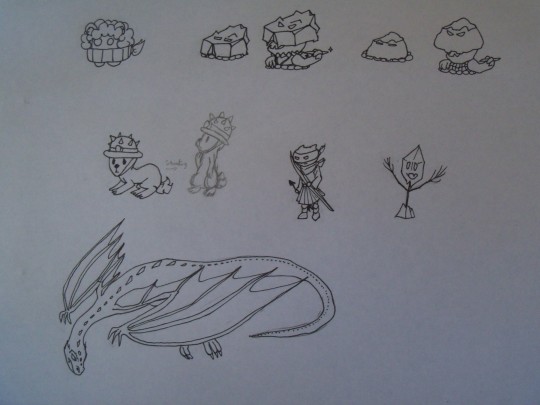
Fullsize Image Links:
Arctic Camp
Arctic Village
Scout
Thom
Marshmallow
Other Rapos (Eric, Lilly & Tommy, Jane)
Enemy Concepts
#drawn to life#raposa#arctic village#my art#it's done#it's finally done#please enjoy and appreciate it#long post#scout#thom#marshmallow#eric#lilly#tommy#jane#my ocs#that's the tagging done (I think)#music
15 notes
·
View notes
Text
More Briefly(?)
Is It Time to Rethink Swain's Sequels?
I’ve been wanting to follow up on my last post for some time, but every time start to dig in I get overwhelmed by the sheer size of it.
And if I, who wrote it, am having trouble, I have to believe most of you are also.
To that end I’m reposting it, in an attempt to summarize what I was really trying to say.
In particular, I’m going to be ripping apart the comments that were copied into that post and selecting only what’s necessary for understanding my point.
In this version of this post, I’ll still be keeping some good deal of the original post entirely though. And, to clarify things a bit more, I’ve added some section headers to set off different areas of the post, and added an area where I summarize what the key point of that section is. Occasionally I’ve tried to add paragraph breaks and other whitespace to give the post a less dense look for improved readability.
Somewhat briefer, then:
This article is in response to a guest post by Peter von Stackelberg on K.M. Weiland’s blog, and what he had to say about creating scene structure (An Intuitive 4-Step Process for Creating Vibrant Scene Structure), as well as the questions it raised for myself and others.
An understanding of Dwight V. Swain’s Scene and Sequel technique is necessary for every writer hoping for success, but if you’re unfamiliar with it then reading Weiland’s series on How to Structure Scenes in Your Story should get you up to speed.
This will be my attempt to synthesize Swain’s concepts with what von Stackelberg had to say about creating scene structure, specifically regarding how I feel von Stackelberg’s concepts fits into Swain’s. (It’s entirely possible I’ll find it makes more sense looking at it the other way around—how Swain’s concepts fit into von Stackelberg—though when all’s said and done, I’ve knows about Swain’s work longest.)
When relying on comments left on Weiland’s blog, I’ll give credit to the commenter and note the time/date of their comment.
To begin…
My Initial Thoughts
Here are my initial thoughts before reading any of the comments readers left. That is, my initial thoughts based solely on von Stackelberg’s post.
I believe before implementing von Stackelberg’s four questions under “Scene Structure as a Writing Template”, writers must understand the character’s scene goal.
Once the character’s scene goal has been determined, it’s possible to proceed to those four questions. After they’re used to flesh out the scene, they can be interwoven into Swain’s scene structure. Sequels are another matter entirely.
The resulting merging of the steps looks like this:
Step 1: Identify the POV character’s immediate goal for this new Scene.
Step 2: Determine what the Scene’s Peak action is.
Step 3: Identify what set into motion the Peak action? What is the Initiate element?
Step 4: What is the result of the Peak action? What is the Release?
Step 5: Where did this all happen? When? Who was involved? This is the Establish element.
Step 6: Fill in Orienting information about the setting, timing, or context of the scene which will help the reader understand the where, when, and who of the scene.
Step 7: Fill in additional Details about character’s, settings, or significant objects in the Initiate (or, sparingly, the Release) elements.
Step 8: Add Prolongs, additional actions that prolong the overall action, to create suspense—which heightens dramatic tension—typically in the Initiate sequence (or, rarely, in the Release sequence.)
Step 9: Write the Sequel (Reaction, Dilemma, Decision) as normal, creating the character’s goal for the next scene.
Key Point of My Initial Thoughts
I believed scenes and sequels were alike, yet different from each other.
My Subsequent Thoughts (During/After Reading Comments)
Reading through all the comments forced me to reconsider some of what I earlier determined to be true. In the comments below, I’ve italicized items of particular interest.
On the topic of cliffhangers:
Based on this snip from a comment from Peter Moore (JULY 13, 2020 AT 12:52 PM):
How do scenes that end with heightened tension fit into this scene structure?
And this snip from von Stackelberg’s response (JULY 13, 2020 AT 1:58 PM):
From the story flow perspective, this kind of cliffhanger is very disruptive for a couple of reasons:
It leaves readers hanging without any sort of resolution to what happened in the scene.
It disrupts the flow of the story because you then need to have the Release at the beginning of the next chapter/scene or, if there are intervening chapters/scenes, at the beginning of the scene where you return to the part of the storyline where you left off with the cliffhanger. The research (and I tend to be a believer in research) tells us that the sequence of Establish > Initiate > Peak > Release is important for readers/viewers understanding of what happens in a scene.
As a writer, I want my scenes to end in a way that prompts readers to move on to the next chapter.
You can certainly do it by going Release (for previous scene) > Establish > Initiate > Peak. However, as both a writer and a reader, that sequence of elements leaves me feeling unsatisfied. I want some sort of conclusion to the scene.
I think the answer to “Where do you end a chapter?” is not in moving the Release to some other chapter, but to focus on using the Release as a place where you basically let your audience know whether the scene’s main character achieved his/her scene goal. The suspense comes not from withholding information (i.e. the Release), but by adding a tidbit of new information.
For example, your protagonist has achieved (or not achieved) his/her scene goals but…is now in deeper doo-doo because…
This raising and releasing of dramatic tension is a real challenge to pull off. Once you master it, however, you are well on your way to writing some real page-turners.
And this response (JULY 22, 2020 AT 11:07 PM):
Your comment about not liking cliffhangers resonated with me. Giving the reader more information to ratchet up the tension is so much more difficult but also more organic/less contrived.
But more relevant information, that builds on what the reader already knows, thrusts/carries the reader forward into the next scene with the confidence that their questions are going to be resolved. They are eager to read to the end of the next scene.
I must conclude that a scene isn’t finished until the Release has been incorporated. The resulting suspense isn’t built so much from “What happened next?” as it is from the reader asking “How did what happened just affect the character, thereby changing the character’s thinking, plans, and the character’s core being?”
Key Point on the Topic of Cliffhangers
Suspense at the end of a scene can be maintained by causing the reader to wonder how what happened to the character is affecting said character.
On the topic of mapping Swain’s concepts to von Stackelberg’s for vibrant scene structure:
Based on this comment from Jennifer Bobrowicz (JULY 14, 2020 AT 9:40 AM):
Your article helps me better understand how to keep my scenes focused while including important details. In a nutshell, the scene’s Peak drives the writing of that scene.
However, I’m confused on how I could use your framework along with the model of scene/sequel KM Weiland explains in her books. Katy’s method has helped immensely with structuring my WIP, but I’d like to know if I can meld the two. So, here are my specific questions.
The Peak Action seems like it could be the Disaster in the Scene (Weiland) and the Outcome [Micah Charlson’s note: I believe this is the Release?] seems like it could apply to the Reaction in the Sequel (Weiland). The Outcome would then go into the next scene or even the next chapter. Your framework has scenes divided into 4 parts, while Katy shows two types of scenes (Scene/Sequel) with each divided into 3 parts. Perhaps, I’m splitting hairs or not fully understanding something. The Scene/Sequel framework (Weiland) seems to work well in establishing goal, conflict, and a mini climax (Disaster in the Scene), and then it (hopefully) keeps the reader wondering how the character will respond in the next scene/chapter.
So, can the two methods be melded together? In your opinion, is ending with the Peak and picking up with the Outcome a mistake? Do I understand correctly that the scene should be wrapped up (no cliffhangers) with the Outcome, then a new question should be raised to keep the reader going?
And this partial response from Peter von Stackelberg (JULY 14, 2020 AT 1:51 PM):
…
These two scenes from “All the President’s Men” — https://www.youtube.com/watch?v=Gn3MSQogVeY — for a great example of how to use the Establish > Initiate > Peak > Release structure. As well, these two scenes are an excellent example of how to do the 1-2 punch of Scene & Sequel that Katie talks about.
The terminology of “Scene” and “Sequel” can, I think, be somewhat misleading because it makes it appear that there is one of each. In fact, I think as Katie has pointed out, both the “Scene” and “Sequel” are scenes as we would normally define them — they have their own set of characters interacting in a well defined time and space.
Both the initial scene and the one that follows should be developed using the E.I.P.R. structure. In the clip from All the President’s Men, these phases are pretty clear in the first scene but a little more subtle in the second scene but also follows the E.I.P.R. structure.
I’ll admit this twists my thinking a bit. To explain, I’ll use the following definitions of Scenes and Sequels as I’ve always understood them:
A Scene is a scene in which the character attempts to achieve an immediate goal—this attempt being one type of action in the cycle of “Goal, Conflict, Disaster”, though I prefer the terminology of “Goal, Conflict, Outcome”—in the service of achieving the overall story goal, whatever that may be. I think I’d say most of the time, if not always, Scenes provide the external action, or the plot. (But it is early as I write this, “early” herein defined as “I haven’t had nearly enough coffee yet.” Still, I’d bet I’m correct, keeping in mind I did say “most of the time.”)
A Sequel is a scene in which the character processes the Scene’s Outcome (good or bad)—this processing itself being simply another type of action, in the pattern of “Reaction, Dilemma, Decision” (leading to the next Scene’s Goal.) So a Sequel, it could be said, is just a scene with a different type of goal than the goal of a Scene:
The goal of a Sequel could be stated as “to process the previous Scene’s Outcome, weighing the pros and cons of each option going forward, and considering all the benefits and consequences inherent in each possible action, in order to determine the best course of action for continuing to pursue the overall story goal.” This processing of the Outcome is, in a Sequel, known as the Reaction. (This is a kind of cost-benefit analysis (CBA) of the contemplated actions for the next Scene.)
This pursuit of the Sequel’s goal—the actual performance of the CBA if you will—is the Sequel’s version of the Scene’s Conflict, which in a Sequel is called the Dilemma, an internal conflict.
This internal conflict, this CBA (even if a team effort, with much back and forth dialogue and apparent plot action) must lead the character—alone, in essence—to make a Decision (the Sequel’s version of the Scene’s Outcome) he or she will commit to—if only in the short term. This commitment to the Decision will always be initially an internal act, even if expressed explicitly after the Decision has been made. (You gotta decide before you can tell anyone what you’ve decided, right?)
Key Point on the topic of mapping Swain’s concepts to von Stackelberg’s for vibrant scene structure:
Sequels are Scenes where the Goal, Conflict, and Outcome are internal versus external, and thus have the same structure.
Are sequels even needed?
Now, before I make my controversial suggestion here, let it be known that I still believe Dwight Swain was a genius and I’ll highly revere all that he’s taught all of us.
That said, if a Sequel is simply another type of Scene, and should be developed no differently than a Scene employing the overlying mesh of E.I.P.R., then perhaps it’s time to scrap the idea of a Sequel completely. Because, in reality, a Sequel could also be viewed as having these parts:
Goal (react to the Scene’s Disaster and determine the next course of action—i.e., the next Scene’s Goal)
Conflict (struggle within—i.e., an internal conflict—with the pros and cons alternative courses of action and the consequences of each; literally, a Dilemma)
Outcome (whereby a decision is reached and the next Scene’s Goal is established)
So, it might be helpful (to some of us) to forgo any thought of writing Sequels altogether, and instead think of writing internal Scenes in their place.
That’s probably the same end result, but changing our own internal thought processes might point our minds in different directions, and unlock other possibilities for our stories.
Another possibility is when, while reviewing previous work writing in the Scene/Sequel format, making the attempt at looking at these Sequels through this different lens.
In Conclusion
So, finally, bringing all this back to von Stackelberg and his excellent post, each scene—Scene or Sequel—will end with an Outcome, which will require the Release element be incorporated into the Scene (external/“Scene”, or internal/“Sequel”.) Deleting Step 9 from the merging that resulted, the steps look like this:
Step 1: Identify the character’s immediate goal for this new Scene
External: What action has the character decided upon after the last internal scene.
Internal: How did the previous scenes Outcome affect the character as he or she begins to come to a decision what to do next?
Step 2: Determine what the Scene’s Peak action is.
Step 3: Identify what set into motion the Peak action? What is the Initiate element?
Step 4: What is the result of the Peak action? What is the Release?
Step 5: Where did this all happen? When? Who was involved? This is the Establish element.
Step 6: Fill in Orienting information about the setting, timing, or context of the scene which will help the reader understand the where, when, and who of the scene.
Step 7: Fill in additional Details about character’s, settings, or significant objects in the Initiate (or, sparingly, the Release) elements.
Step 8: Add Prolongs, additional actions that prolong the overall action, to create suspense—which heightens dramatic tension—typically in the Initiate sequence (or, rarely, in the Release Peak sequence.)
I promise you, I still have some unsettled feelings on some level that I’m having trouble coming to grips with, let alone being able to articulate. But when that day comes that I can put what I’m feeling into words, I’ll have more to say on the topic.
And, hopefully, with more brevity. Looking back at what I've been able to trim from the previous post, it is still a behemoth. In the meantime, all I can say is: stay tuned.
3 notes
·
View notes
Text
PORTFOLIO IN EMPOWERMENT TECHNOLOGY
CHAPTER 1 LESSON 1: INFORMATION AND COMMUNICATIONS TECHNOLOGY - Is a branch of engineering that involves the conception, design, manufacture, and operation of robots. This field overlaps with electronics, computer science, artificial intelligence, mehcatronics, nanotechonology and bioengineering. CONTENT STANDARD
- The learners demonstrate an understanding of ICT in the context of global communication for specific professional track.
Performance Standards
- The learners shall be able to: at the end of the 2-week period independently compose an insightful reflection paper on the nature of ICT in the context of their lives, society, and professional tracks (Arts, Tech Vocational, Sports and Academic)
Most essential learning competencies
The learners should be able to:
1. Compare and contrast the nuances of varied online platforms, sites, and content to best achieve specific class objectives or address situational challenges.
2. Apply online safety, security, ethics, and etiquette standards and practice in the use of ICTs as it would relate to their professional tracks. 3. Use the internet as a tool for credible research and information gathering to best achieve specific class objectives or address situational.
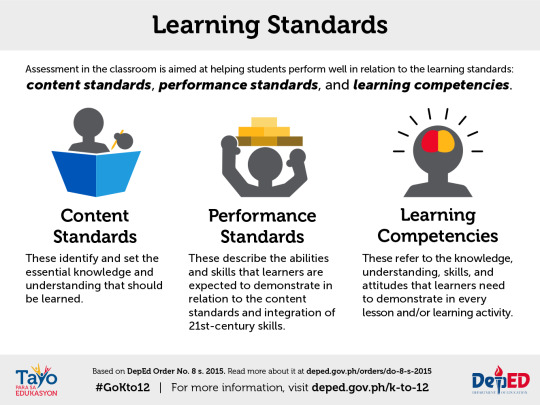
1.1 INFORMATION AND COMMUNICATION TECHNOLOGY

- ICT is the technology required for information processing, in particular, the use of the electronic computers, communication devices and software applications to convert, store, protect, process, transmit and retrieve information from anywhere, anytime.
- Information refers to the knowledge obtained from reading, investigation, study or research. The tools to transmit information are the telephone, television and radio. Information is knowledge and helps us to fulfill our daily tasks. - Communication is an act of transmitting messages. It is a process whereby information was exchanged between individuals using symbols, signs or verbal interactions. Communication is important in order to gain knowledge. Technology is the use of scientific knowledge, experience and resources to create processes products that fulfill human needs. Technology is vital in communication.
- ICT nowadays has also widened the horizon in developing new tools or emerging technologies. Mobile devices can communicate through wireless fidelity (Wifi), Bluetooth, third generation 3g & 4g, data services and dial up services and virtual private networks. EMERGING TECHNOLOGIES

- Artificial Intelligence (AI) - is the ability of a digital computer or computer controlled robot to perform tasks commonly associated with intelligent beings. The term is frequently applied to the project of developing systems endowed with the intellectual processes characteristics of humans, such as the ability to reason, discover meaning, generalize or learn from past experience. ROBOTICS

- Is a branch of engineering that involves the conception, design, manufacture, and operation of robots. This field overlaps with electronics, computer science, artificial intelligence, mehcatronics, nanotechonology and bioengineering. BIOMETRICS

- Are a way to measure a person’s physical characteristics to verify their identity. These can include physiological traits, such as fingerprints and eyes, or behavioral characteristics, such as the unique way you’d complete a security-authentication puzzle. QUANTUM CRYPTOGRAPHY

- Also called quantum encryption, applies principles of quantum mechanics to encrypt messages in a way that it is never read by anyone outside of the intended recipient. COMPUTER ASSISTED TRANSLATION

- Involves the use of software programs to translate both verbal and written texts. Also known as machine-assisted or machine aided translation. 3D IMAGING AND HOLOGRAPHY

- Is defined as a 3D projection that exists freely in space and is visible to everyone without the need for 3D glasses. VIRTUAL REALITY

- Refers to the computer generated simulation in which a person can interact within an artificial 3D environment using special electronic devices that can be similar to or completely different from the real world. ONLINE SAFETY

- Is the knowledge of maximizing the user’s personal safety and security and risk to private information, and self-protection from computer crime in general. 1. Know the scams - Learn about different kinds of scams and what you can do to avoid them.

2. Think before you click - Think twice, thrice and zillion time before click any link or buttons.

3. Safety Peruse - These sites may have an Address that’s very similar to a legitimate site, but the page can have misspelling, Bad Grammar, or low resolution Images.

4. Shop Safety - Don’t shop on a site unless it has “https” and a padlock icon on the left or right in the URL.

5. Kick-butt passwords - Use an Extremely uncrackable password One like “9&4thkel965#”.
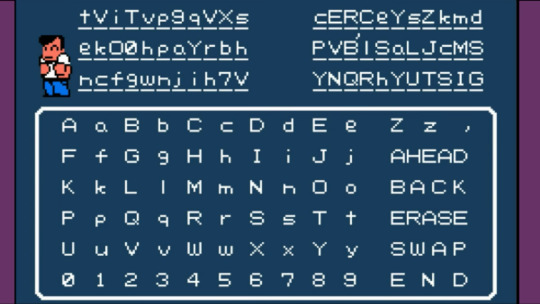
6. Protect your info’s - Keep your guard up, Back up all your data on your computer, smartphone and tablet, theft or a cash.

7. Watch your Wi-Fi Connectivity - Protect your network by changing your router’s setting and making sure that you have the connection password protected.

8. Install a Firewall - A firewall is a grate line of defense against cyber attracts.

9. Keep up to date - The best security updates automatically to protect your computer. - Use the manufacturer’s latest security patches to make regular updates and make that you have the software set to do routine scam.

10. Use your Noggin - Use your common sense while surfing the web.

COMMON ISSUES AND CRIMES IN THE INTERNET - CYBERBULLYING - HACKING - IDENTITY THEFT - PLAGIARISM - COPYRIGHT ISSUES CYBERBULLYING - Is a form of bullying or harassment using electronic means. Cyberbullying and Cyber Harassment are also known as online bullying. - Cyberbullying is when someone, typically teens, bully or harass others on the internet, particularly on social media sites. Harmful bullying behavior can include posting rumors, threats, sexual remarks, a victims’ personal information, or pejorative labels. THE ANTI-BULLYING ACT OF 2013 ( RA 10627 )
(Sec. 2, RA 10627) These acts are collectively “called cyber bullying” when committed online. (Sec. 2-D, RA 10627) This covers social bullying aiming to belittle another individual or group or gender-based bullying that humiliates another on the basis of perceived or actual sexual orientation and gender identity. (Sec. 3, B-1 RA 10627. Implementing Rules). THE REVISED PENAL CODE AND THE CYBERCRIME PREVENTION ACT. - One who publicly or maliciously imputes to another a crime, vice, defect, real or imaginary, or any act, omission, condition, status or circumstance tending to cause the dishonor, discredit or contempt of a natural or juridical person, or blacken the memory of one who is dead may be liable for libel under this Code. (Art, 353, RPC) These acts are more severely punished when done online in addition to the civil action for damages which may be brought by the offended party. (Sec. 4(c-4), RA 10175) Cyberlibel holds liable only the original author of the post (Sec. 5(3), Implementing Rules of RA 10175) Likers or shares of a post cannot be held liable under this law. - Slander may also be applicable to one who, in heat of anger, utters statements that are highly defamatory in character. (Art 358, RPC) Intriguing Against Honour may also find applicability when the principal purpose is to blemish the honour or reputation of a person. Hence, a blind ite is not as actionable as a named-post in social media. HACKING

- Hacking generally refers to unauthorized intrusion into a computer or a network. The person engaged in hacking activities is known as a hacker. This hacker may alter system or security features to accomplish a goal that differs from the original purpose of the system. - Hacking can also refer to non-malicious activities, usually involving unusual or improvised alterations to equipment or processes.
IDENTITY THEFT

- Also known as identity fraud, is a crime in which an imposter obtains key pieces of personally identifiable information, such as Social Security or driver's license numbers, in order to impersonate someone else. TYPES AND EXAMPLES OF IDENTITY THEFT 1. True-name identity theft means the thief uses personal information to open new accounts. The thief might open a new credit card account, establish cellular phone service or open a new checking account in order to obtain blank checks. 2. Account-takeover identity theft means the imposter uses personal information to gain access to the person's existing accounts. PLAGIARISM
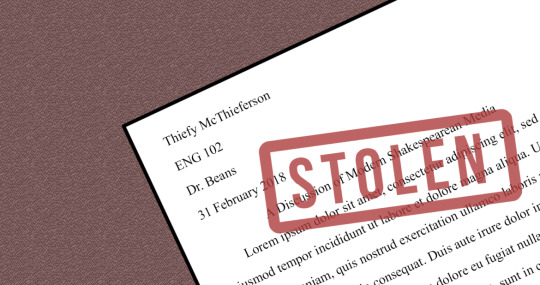
- Is an act of fraud. It involves both stealing someone else's work and lying about it afterward. The following are considered plagiarism - turning in someone else's work as your own - copying words or ideas from someone else without giving credit - failing to put a quotation in quotation marks - giving incorrect information about the source of a quotation - changing words but copying the sentence structure of a source without giving credit - copying so many words or ideas from a source that it makes up the majority of your work, whether you give credit or not (see our section on "fair use" rules) Republic Act No. 8293 [An Act Prescribing the Intellectual Property Code and Establishing the Intellectual Property Office, Providing for Its Powers and Functions, and for Other Purposes]otherwise known as the Intellectual Property Code of the Philippines. Intellectual property rights under the I. P. Code: The intellectual property rights under the Intellectual Property Code are as follows: 1. Copyright and related rights; 2. Trademarks and service marks; 3. Geographic indications; 4. Industrial designs; 5. Patents; 6. Layout designs [topographies] of integrated circuits; and 7. Protection of undisclosed information. The scheme of penalties for infringement has also been changed. From the previous fine of Php200 to Php2,000 and/or imprisonment of 1 year, the current range of penalties are as follows: - For first offenders - fine of PhP50,000 to PhP150,000 and/or imprisonment of 1 to 3 years - For second offenders - fine of PhP150,000 to PhP500,000 and/or imprisonment of 3 to 6 years - For third and subsequent offenders - fine of PhP500,000 to PhP1.5 Million and/or imprisonment of 6 to 9 years. - In case of insolvency, the offender shall furthermore suffer subsidiary imprisonment. NETIQUETTE - Is a combination of the word net and etiquette.It focuses on the acceptable behavior of a person while using the internet resource. - It focuses on the acceptable behavior of a person while using the internet resource. The Core Rules of Netiquette Rule 1. Remember the human. - Never forget that the person reading your mail or posting is, indeed, a person, with feelings that can be hurt. - Corollary 1 to Rule #1: It's not nice to hurt other people's feelings. - Corollary 2: Never mail or post anything you wouldn't say to your reader's face. - Corollary 3: Notify your readers when flaming. Rule 2. Adhere to the same standards of behavior online that you follow in real life. Corollary 1: Be Ethical Corollary Corollary 2: Breaking the law is bad Netiquette. Rule 3. Know where you are in cyberspace. Corollary 1: Netiquette varies from domain to domain. Corollary 2: Lurk before you leap. Rule 4. Respect other people's time and bandwidth. Corollary 1: It's OK to think that what you're doing at the moment is the most important thing in the universe, but don't expect anyone else to agree with you Corollary 2: Post messages to the appropriate discussion group.Corollary 3: Try not to ask stupid questions on discussion groups Corollary 4: Read the FAQ (Frequently Asked Questions) document Corollary 5: When appropriate, use private email instead of posting to the group Corollary 6: Don't post subscribe, unsubscribe, or FAQ requests Corollary 7: Don't waste expert readers' time by posting basic information Corollary 8: If you disagree with the premise of a discussion group, don't waste the time and bandwidth of the members by telling them how stupid they are.Just stay away Corollary 9: Conserve bandwidth when you retrieve information from a host or server. Rule 5. Make yourself look good online. Corollary 1: Check grammar and spelling before you post Corollary 2: Know what you're talking about and make sense Corollary 3: Don't post flame-bait Rule 6. Share expert knowledge. Corollary 1: Offer answers and help to people who ask questions on discussion groups Corollary 2: If you've received email answers to a posted question, summarize them and post the summary to the discussion group. Rule 7. Help keep flame wars under control. Corollary 1: Don't respond to flame-bait Corollary 2: Don't post spelling or grammar flames Corollary 3: If you've posted flame-bait or perpetuated a flame war, apologize Rule 8. Respect other people's privacy. - Don't read other people's private email. Rule 9. Don't abuse your power. - The more power you have, the more important it is that you use it well Rule 10. Be forgiving of other people's mistakes. CONTEXTUALIZED ONLINE SEARCH AND RESEARCH SKILLS

- Online search is the process of interactively searching for and retrieving requested information via a computer from databases that are online. Interactive searches became possible in the 1980s with the advent of faster databases and smart terminals. Advantages and Disadvantages Advantages: - Ability to obtain a large sample, which increases statistical power - Data is automatically coded so no data entry errors - Reduced cost of conducting research Disadvantages: Online is not totally secure and theft is one of the numerous danger it poses, researchers personal information is at risk of being access by rogue persons. - Some of the materials on the internet have not been evaluated by experts or thoroughly screened - Lack of accreditation and low quality
RESEARCH SKILLS “Research” sometimes just means finding out information about a topic.You can certainly develop advanced information retrieval skills in Working with Sources. However, in specific understandings of “research” carry a lot of weight. The classic definition is that “research” leads to an original contribution to knowledge in a particular field of inquiry by defining an important question or problem and then answering or solving it in a systematic way. - So you will need to read on to develop a relevant understanding of what research means in your subject. - Research skills can be anything from looking at competitors and seeing what they do well to producing a written report on how your department could work better. Doing research in the world of work is all about stepping back from your day-to-day work and looking at ways you can improve. Important aspects of research: - Research design covers the key issues in developing a successful research project. - Research methods takes you to resources on essential techniques for carrying out convincing research. - Working with data will provide resources on the use of statistics and other numerical skills in research. Improving Your Research Skills Online 1. Know your sources. Make sure to find the most reliable information which can be found in multiple sources or, better, to have the original source. 2. Use your web browser properly. Know the capabilities of your preferred browser to help make your search faster and easier. 3. Organize your bookmarks. It is to organize the links you have marked. 4. Learn to use advanced search engines. Practice using advanced search techniques which are available in Google. 5. Follow the web. Follow the web information in the web. Just make sure to read and be critical in every link you click. SIX STRATEGIES THAT CAN HELP ONLINE STUDENTS PRODUCE STRONGER RESEARCH. 1. Contact a librarian before getting stuck sifting through piles of online information. 2. Consider that when in doubt, it's wiser to over-cite sources than risk plagiarism. 3. Use Google and other reliable resources at the beginning of a research process, not the end. 4. Don't think that the Web is your only source of information. 5. Understand the professor's expectations for citation format. 6. Understand why professors still assign research projects. Some examples of research skills that you may have include: 1. Report writing. 2. Analyzing lots of information from different sources. 3. Finding information off the internet. 4. Critical thinking. CHAPTER 2 APPLIED PRODUCTIVITY TOOLS Productivity Tools - It is a tools that can be a freeware or shareware. Freeware - is copyrighted, which can be used for free and for an unlimited time. Shareware - is a commercial software that is copyrighted, which can be copied for trial but needs to be purchased for continued use. Advanced Techniques Using Microsoft Word Microsoft Office Word

- One of the software of Microsoft Office 2013 suite. - Offers a set of tools that is compared to its previous versions. - Along with its new features are advanced techniques including hyperlinks, macros and mail merge. Hyperlink

- A link that will direct you to another page or part of the same document. Creating a Hyperlink to an Existing Document - Suppose you are to link a part of your document to an existing document. - Click your mouse on the location in the document where you want to insert the hyperlink. - On the Insert Tab, click the Hyperlink button on the Links group. - On the Insert Hyperlink dialog box, click Existing File or Web Page and then select the File name where the source file is located and then hyperlink will be created on your document. - Press Ctrl+ click on the Hyperlink to open the linked file. Mail Merge

- Is a useful tool that allows you to quickly produce and send information, newsletter, resumes, or brochures to many people. Creating a Mail Merge 1. Open the word document that you want to Mail Merge. 2. On the Ribbon, click the Mailings tab, go to the Start Mail Merge group and click Start Mail Merge and select Step by Step Mail Merge Wizard. 3. The task pane will show the Mail Merge steps 1 to 6. PowerPoint

- It allows you to create slide show presentations wherein you can format the texts and images, adding also animations and other multimedia components interactively. Excel

- One of the applications created by Microsoft, used to simulate a paper worksheet.
- It is composed of cells that are represented in rows and columns design to perform basic arithmetic operations. - Widely used in accounting and financial applications, as well as statistics and engineering calculations. The following are the common Excel Functions: = SUM – Calculates the sum of the values of a range of cells = AVERAGE – Calculates the arithmetic mean of a range of cells = MAX - Gives the maximum value in a range of cells = MIN - Gives the minimum value in a range of cells = COUNT - Counts the number of cells in a range of cells BENIFITS OF ONLINE SOFTWARE Convenience - The applications should be intuitive and easy to use to ensure everyone can use them without spending a lot of time learning how. Scalability - The applications should be able to be used in all areas of your business and also work effectively no matter how much demand there is to use them or how much your business grows. Safety - All the applications should be safe to use with all existing systems and should have the ability to fully integrate with all other software and not inhibit the workers ability to do their job. Sustainability - All consumer-based software should be flexible and adaptable to have the ability to last for up to 10 years, but they must be able to expand functionally with other developments in software and operating systems. PRINCIPLES OF GRAPHICS AND DESIGN BALANCE UNITY MOVEMENT REPITITION PROXIMITY CONTRAST WHITESPACE BALANCE

- Describes the placement of elements of equal weight on the page. MOVEMENT

- Describes the flow of elements on the page.
1 note
·
View note
Text
Book Club: Tallstar’s Revenge, chpt. 1-9 overview.
Thoughts on the new Windclan, courtesy of famed Erin Hunter impersonators:
“DIRT BOYS!! LET'S MAKE THEM ALL DIRT BOYS!” -- K.
"I understand we've stressed extensively that ALL Windclan love running and are skinny binches and need to be under the sky or they're sad, BUT half the clan has always been buff as fuck and live like moles :) :) we just didn't mention it before because it wasn't important to Harry's journey :) :) :)” -- S.
For this first share, we’ll keep to the questions posted earlier in the week so that there’s some kind of structure to what we’re doing! Please feel welcome to do the same and @ailuronymy + use the tag #ailuronymy writing challenge. Happy reading and I’m looking forward to seeing your feelings about this book.
1. First impressions?
S. better than Bluestar's Prophecy. K. Not as bad as BP but also hoo boy, you peel back the onion and it only gets uglier the more you think about it huh K. Me, reading the book initially: Wow I actually kind of enjoyed this! Me now: I See. I See The Truth.
2. How did you feel reading this section?
S. mostly the usual amount of exasperation! But it was also fun and I like Tallpaw K. About the same! Not as bored as BP, and I do like Tallpaw, so that's a blessing in disguise.
3. What chapter did you find most interesting/moving/effective, and why?
S. probably the one where Heatherstar causes a ruckus and acknowledges Tallpaw's best interests. There was genuinely tension and it was refreshing to have a character in authority actually act reasonably towards Tallpaw. K. I agree, that one had me really excited to read.
4. What chapter did you find least interesting/effective/most frustrating, and why?
S. I honestly struggled with chapter eight. If I have to read too much action being described, I black out. I just find it so boring. That's not actually a criticism at Erin Hunter. I just have a short attention span for people Doing Things that aren't talking, sword-fights, having big emotions, sex, or any combination. And even then, the sword-fights and/or sex still have to keep to a reasonable word limit or I wander away. I'm the worst. I'm literally like a child who only wants to eat sweets, but in written form. S. I forgot basically all of chapter eight for the above reason of being terrible, so that's on me.
K. I have nothing written at all about Chapter 7. I liked seeing the apprentice training being like, at least marginally different than Thunderclan's but also It Sucked Bad Chapter Moving On.
5. Is there a passage that stuck in your mind–for good, or not-so-good reasons? What is it, and why did it stand out? Try breaking it down and analysing what this passage does and how.
S. I actually had a nice time reading about Plumclaw and Tallkit interacting. She was talking him through having his first mouse, I think, and it was genuinely sweet and moving in a way that Erin Hunter's writing almost never is. There was a legit connection and for a moment, I actually believed in these characters as people who lived together and actually have relationships and care. That’s really what I’m about, so it was a pleasant surprise to find in this book.
K. I have two brief passages for different reasons: “He’s my son,” Sandgorse snarled. “I’ll decide his future.” Heatherstar stiffened. “I decide the future of my warriors.” LOVE Heatherstar showing the fuck up. Absolute legend. K. “Tallkit heard worry in her mew. “Is that why we tunnel under the moor?” he asked. “To hide from the dead warriors in other Clans?” — First tunnelling mention! The idea of Windclan taking shelter from/expertly evading the ghosts of their enemies because of their speed is honestly pretty fun, but I don’t trust the Erins with it one bit. K. This kind of legend is something I think I'd much prefer in like, a Watership Down style myth or story? K. But not if Erin's touching it. S. I was like, "oh this is the sickest thing you've ever--no no no no no" K. (oh, and just for fun, one of my other fave quotes was Dawnstripe saying "We guard the edge of the world." That felt cool.)
6. What themes did you notice in these chapters? What motifs or repeated symbolism/description appeared to you?
K. Love is a big one, obvs. K. Also, lots of stories and storytelling? Which feels just like Erin slapping more bullshit in here but like, that feels kinda relevant.
S. I struggled to find cohesive themes in this chunk, except I think division? The division between the tunnellers and moor runners, between Tallpaw and his mum, between Heatherstar and her clan. That's really what popped for me.
K. Oh, and like... expectations. The clan's expectations of Heatherstar, Sandgorse's of Tallpaw, Tallpaw's expectations for himself.
7. How do you feel about the characters, their motivation, their choices?
K. They're like. Not the worst? Lots of them fucking suck, as usual. But I'm at least very happy that I actually want to see Tallpaw succeed and grow. Also Heatherstar and Dawnstripe and Barkpaw are great.
S. I like Tallpaw! That's a lot of projection on my part, but I've found him a lot less grating than Bluepaw (who I also wanted to love). S. One of my first major aggravations in the early chapters is Shrewpaw. He's unbearable, and what makes him so is the one-note bullying. It's the equivalent of reading someone go, "I'm not touching you," in an annoying voice for nine chapters, which I feel is another example of Erin Hunter's habit of repetition. There was less of that in this book than BP, but I still counted a few instances of cats having the same conversation a few times. S. The other cat I can't stand is Sandgorse. My god. That moment when he tells his literal infant son to go cheer up his depressed mother made me just about scream. S. “Go cheer up your mother, child” GO CHEER UP YOUR WIFE, HUSBAND
K. This is where it's gonna get interesting, because I think my fucking senses were dulled by how much Erin fucked up dads last time, because I didn't hate him off the hop!
S. To me, he smacks of a lowkey toxic masculinity. And the kind of emotional manipulation he does makes me [narrow eyes]. S. (I didn't take very good notes about this bit, because I forgot. I only have "Sandgorse is such a loser" but I trust past me's judgement).
K. I strongly do think that my impression of Sandgorse is different if only because I think I was so tired at seeing all the non-existent dads in Bluestar's Prophecy that the fact that he actually has conversations with his son and wife for more than like, a sentence, made me go "Oh thank god" And maybe this too is a bit of a projection, but I sort of initially saw him as like... that well-meaning dad who tries to be nice but still manages to fuck up and not actually listen to what people need at all. Like, the classic stupid dad in a bad TV movie who has A Dream for his kid. Where he doesn't mean to be an asshole, he just thinks he's right and that his kid agrees with him because Why Wouldn't He. So I think I took a lot of his dialogue and actions to be a bit more well-meaning-but-still-not-great rather than fully toxic. Obviously it doesn't end well for anyone, but I guess I've just seen too many father figures go around with nice intentions who have absolutely Zero ability at reading a room let alone their kids
S. I think for me, that is the problem. And I think I am less forgiving towards it.
K. Stormtail [Bluestar’s father, Bluestar’s Prophecy] feels like more of the asshole dad, to me, but like. They're both different brands of Not Good.
S. Stormtail is super just a complete prick, no doubt. I think Sandgorse is more engaged with his kid, for sure. But I think it's a very hollow engagement, because he denies everything about Tallpaw's actual personality and desires and just sees him as an extension of himself to control. Which is sort of parental abuse 101.
K. Oh, and while we're discussing them: Palebird huh. Again, Erins, can't write a woman, but like. I don't know, I think that like... she felt like a neat character for the first chapter and now they're doing their Bad Things with her by making her boring and Just Sad and kind of useless in the background for them to mess with and probably kill off later. Like, she doesn't have a whole lot of personality, but she could. S. I think I'd like all the characters more if I spent less time with them. Like, I think for me, the pace is too slow, the dialogue is too long, and because of that, I get bored and annoyed with the characters. Whereas I think if it was only a couple of chapters, forcing the dialogue to be more punchy and illuminating of their character, and less mired in sadness (Palebird) or digging stupid holes (Sandgorse) or bullying (Shrewpaw), I'd have a lot more fun. But as it stands, Palebird starts talking and I start zoning out because they've really done her so dirty in this.
8. If you could ask any character in this section a question, what question would you ask them?
K. Heatherstar: How does it feel to be the baddest bitch in the room at any given moment K. Palebird: Why the FUCK are you with this bastard K. Sandgorse: WHY are you LIKE THAT ALL THE TIME
S. Barkpaw: what is it about learning medicine that you love? Or.... Barkpaw: how did you decide to give up your future with others, for a future in medicine? What was that decision like?
K. A more serious question from me, hehe: Tallpaw - If no one was watching, what would make you happiest to do or say? K. Shrewpaw: What about yourself do you feel most inadequate about? What part of that drives you to act towards others like you do?
S. Shrewpaw: what's your fucking damage, buddy?
9. In your opinion, what is “world-building” and how important is it to you as a reader (or writer)? How do you feel about the world-building of these chapters so far? If you could, would you change anything, and what would you change?
S. Oh, I hate it. S. What's hilarious is that for maybe the first time ever Erin Hunter is putting effort in. You can see how hard they're working to make tunnelling sound "cool" or relevant, how they're describing all these tunnel-related skills and techniques the way they do with fighting or whatever. S. And the irony is it's such a wasted effort because personally? Could not care less. This world-building enraptures me none amount and I spend the whole time scoffing like, sure Jan.
K. One of my notes off the hop is: "I know that Erin’s trying to like… make Windclan look unique by adding these new positions, but just labelling some warriors as “moor runners” doesn’t cut it. Their job is: “hunting and patrolling the borders”. That’s just? An average warrior thing to do? It’s not special, and naming it something fancy doesn’t make me feel like you’re actually adding anything to Windclan’s mythology here." Which is really just tunnel adjacent, but it's still relevant.
K. Other choice tunneling notes: "...Listen, I get it, inter-clan conflict is wonderful. But WHY do the moor runners and tunnellers hate each other? If the tunnels are so important to Windclan’s way of life, SURELY the above-ground warriors would feel respect for them? And if Windclan holds such value in their tunnels (Palebird literally just said that the tunnels mean they’re “stronger and cleverer” than the other clans), then WHY would Windclan cats hate them for it?? To have this weird seemingly generational distrust between the two castes is just. Fucking bananas." k. "Hey Erin: Why introduce the tunnellers at all if you keep putting them down and saying how much worse it would be to be one. What’s the point."
S. “I'm still not over the fact they're [Erin Hunter] like... "what can we do to make Windclan, the clan who famous won't even build nests because they like to live under the stars, special and different from the rest... oh I fucking know."
K. "Why is no one in charge in this clan that’s been a tunneller?? Heatherstar and Reedfeather just… fully don’t understand tunnelling and tunnellers needs?? If I were making this system, I’d have it be mandatory that the leader and deputy have to be one from either caste." S. Why not just ban it already. S. I mean, the book tries so hard to convince us tunnelling is useful. I believe none of it.
K. ALSO why don't the tunnelers b a t h e K. "They're permanently soiled with dirt and soot" DO THEY BATHE??? DO THEY?? WHY DO YOU HATE THIS NEW CASTE THAT YOU SEEM TO LOVE? K. Erin Hunter: look at my cool new worldbuilding set! I'm going to shit on it for an entire book
K. Like. I'm having a hard time pinpointing what I would do better, but like... I think I want it to feel 1) more cohesive and believable. 2) It needs to be useful and cement this clan as a group of living, working people. It has to make some kind of sense (to an extent) but also have a purpose! 3) sometimes worldbuilding doesn't need to be "uhh they need more jobs" sometimes it can be "we have this myth about running faster than the ghosts of our enemies" and that's just as successful if you do it right. Like, Erin thought you needed to entirely overhaul Windclan and make them Different to make them better. Instead of working with what's already there!
S. I personally feel it doesn't take much to make the clans really different from each other, and it's more the subtle things that make huge differences, not--like you said--more jobs or anything. Really don't want to blow my own horn, but like, to use the chapter I just wrote as an example: just by making elders vote to make major decisions alters the clan significantly. That's just one thing, that's putting different emphasis and a new swing on a preexisting facet of every clan. But immediately you get the effect and it has run-on effects too, which is what good world-building should do. It should be hard to remove any one piece without the whole castle crashing down. And this book is basically about how removing one “major” piece (tunnelling) effectively didn’t change anything, really. K. It just doesn't feel right to me! It's too big a change to feel natural, let alone how fucking bad it is.
K. And like, honestly, the Erins even did okay with just highlighting the territory and environmental differences! I've read all the different fucking ways they can write a forest after 30 books and they really have written them all. Even just making THAT a focal point helped to make this book feel somewhat distinct and fresh!
S. One of my long-standing gripes with Erin Hunter is that their environments are boring and basic and they need way more close detail on plants and whatnot but that is a personal preference, and not actually a flaw. Although admittedly, if you do spend time making an environment interesting, it turns out that becomes a reason to read and a pleasure, instead of something you have to trudge through to get to the Actually Good Bits. But that's not what they're about and I can acknowledge that, if not respect it.
Extra notes:
S. [Sandgorse’s] basically the dad equivalent of a pageant mum? K. Yeah! K. Sports Dads are just Pageant Mom Regional Variants. S. Oh my god.
K. The story isn't about [Palebird] and at this point it just feels kind of sad to have her onscreen. S. Yeah, I get the feeling she exists to make Tallstar feels unloved, basically. K. Which sucks! S. "Your mum likes your dead sibling more" is uhh a brutal way to tell a story, Erin.
K. For one: Barkpaw is... the best cat S. YES S. My boy. K. The Erins only know three medicine cats: Softe, Don't Fucking Touch Me, or The Only Reasonable Gay
K. 1) “Tallpaw swallowed a purr. “No racing, I promise. No having fun whatsoever on the dawn patrol.” I Love Him. 2) Dawnstripe seems nice and I think she and Stonepelt need to be friends. 3) I loved Tallpaw's little chase sequence and how clever he is :>
S. I just can't get over how much it breaks my suspension of disbelief to imagine cats digging. S. Of all things. S. I can tolerate the bullshit fighting better than I can believe cats digging with any efficiency whatsoever. K. They remind me of the Meerkats from Lion King 1/2. K. And I. K. Despise. K. That film. S. Windclan: https://www.youtube.com/watch?v=U76zyUFg3Xo K. PLEASE END MY SUFFERING
K. I think what pisses me off about [Shrewpaw] the most, sidebar, is that he's like this from the start. Who is teaching him this??? Who is raising this little monster boy???? Who in Windclan is just? rearing xenophobes???? S. Like, he's newly born and walking around being a little fascist. S. And no-one is doing anything about it! All the adults are like, "huh, yeah, kids, am I right?" K. He isn't even as cool as Thistleclaw! He's just a little mean weasel boy! S. Sandgorse is literally like, "yeah that little weak moor runner punk child, what a coward, scared of getting sand in his eyes." Like, that's not the right response At All. K. EVERYONE IS SO RACIST ALL THE TIME SEND TWEET S. And none of the moor runners are being like, "hey stop calling him wormcat, his name is Tallpaw and he's your clanmate." S. Additional sidebar: Shrewpaw calling Tallpaw "wormcat" is my favourite thing in the book. S. It's like if I walked up to a nerd I didn't like and was just like, "lol wormboy." S. Devastating. K. RIGHT S. It's so funny. I was literally there like, "okay this is bad behaviour, Shrewpaw, that's not the right way to act, but also? fucking hilarious." K. It was funny at the start and now that it's his Thing it's even more funny. Like you can't think of anything better to say that you keep invoking the "Wouldn't you like to know, weather boy?" goof at all hours. S. It kind of reminded me of the time I was teaching and I had to put a ban on the word "Elmo" because the kids kept basically making it a slur on each other, but it was also the funniest thing and it was SO HARD not to fucking lose it. S. Me, being a good teacher: "All right, that's enough, no-one is allowed to call anyone else 'Elmo' anymore." S. Me on the inside: [dying]
13 notes
·
View notes
Text
Only a day or two ago I was notified that I was in contact with some people tested for and found positive for Covid-19, this came as nothing un expected, I was in contact with hundreds of people many from Europe recently. Then, as you know we are experiencing, most Universities, Libraries and Book Shows have been indefinitely closed, and because of this; many of us find or try lively-hood’s challenged. In a situation where it seems that there is little to do that will improve the current situation any faster than time will take its course, I have turned to reading and writing. I have been researching, as best as I can from home, fifteen books which are new to my stock. There are many more stuck in Europe and this gives me hope. It is the first day of spring and I awoke to a beautiful snow squall… In like a Lion..
And here are the fruits…
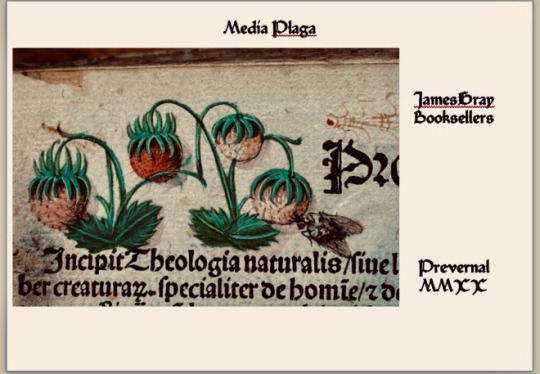
1). 355J Bible Saint Jerome, Gabriello Bruno (active 1480-1514.)
Biblia cum summariis concordantiis : diuisionibus: quattuor repertoriis p[ro]positis: numeriq[ue] foliorum distinctione: terse et fidelit[er] imp[re]ssa. { With table of Gabriel Brunus }
[Lyons]: Jean Pivard, 29 Jan. 1500 & 1. $ 15,000.
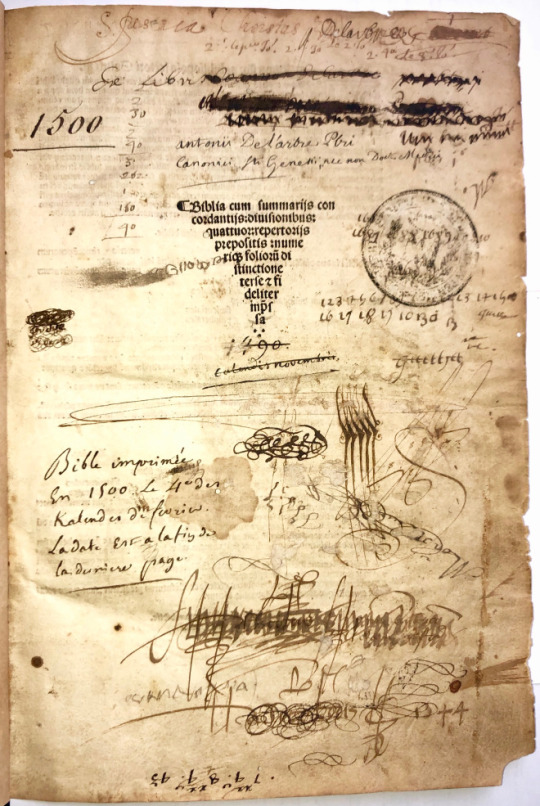
Impresserunt aute[m] solertes viri Franciscus Fradin et Ioha[n]nes Piuard socij impressores. …,]
Folio inches, &8 ç8 , a8 b6, c-z8 A-Z8 Aa8 Bb8; aa-cc8 dd10. Bound in original full calf over wooden boards with 10 brass bosses.
This edition corresponds with the edition printed by Fradin and Pivard in 1497. There are the same tables, summaries, &c.; and the arrangement of the books and the readings are alike. At the end of the subscription we read: “Impressit autem solers ori Johänes Pivard impressor. Deo sint sempiterne gratie.”
Pivard,who was working alone from 7 March 1498 to 1501, Started printing with François Fradin in 1497 (Goff B602) ISTC lists15 titles solely printed by Privard.
Goff B604; HC 3128; GfT 1883, 1884; Pell 2341; CIBN B-426; Arnoult 288; Girard 108; Parguez 213; Polain(B) 4210; IBE 1040; SI 764; Martín Abad B-134; Sallander 2098; Bod-inc B-312; Sheppard 6736; Pr 8670; GW 4281. (Gutenberg-Jahrbuch 1965 p140-3)

Copinger, Incunabula Biblica, 120; Darlow–Moule 6090; Sheppard 6736.
U.S. copies: Boston Public Library, General Theological Seminary, Jewish Theological Seminary of America, Library of Congress, Rare Book Division, Southern Methodist Univ., Bridwell Library (418 ff)

https://data.cerl.org/istc/ib00604000
◊
◊ ◊
◊
2) 353J Alberto da Castello (ca. 1460-1522)
Rosario della gloriosa Vergine Maria : con lle sttattiionii & iindullgenttiie delllle chiiese di Roma perr tutto L’’anno.
In Venetia : Presso la compagnia de gli Vniti,1585. $7,800

Octavo. 6 x 3 3/4. A-Z, Aa-Ii8. A later edition of the first ‘Rosary Book” in Italian.
This book has a wonderful contemporary binding, recently expertly rebacked. It is of red Morocco with gilt center images and borders gilt, with angels. Certainly these books were

very popular, that said, very few copies have survived. This edition is represented on OCLC by only two copies worldwide. 1 US copy Saint Benedict/Saint John’s University. (SJU Alcuin Arca Artium Rare BookBX2163 .C37 1585). [The authorship of the work and the woodcuts are attributable to the Dominican Friar Alberto da Castello, identified as author or editor at the authorizations of the Venecian Inquisition, given 5 April 1521. (Francesco Pisano)]

Over 150 woodcuts (including repeats) comprising almost full-page cuts (1 on t.p.) within borders. All had previously appeared in earlier editions. Ornamental and pictorial border pieces on almost every leaf. ( The wood cut on leaf 173v is upside down in the border!) Each wood cuts represent the “Mysteries of the Rosary”
“From the beginning, publications on the Rosary came accompanied by lavish xilographic illustrations. The most striking of these can be found in the edition of the Rosario della gloriosa Vergine Maria by Alberto da Castello from 1521 [Fig. 14.1], which contains a wealth of illustrations. This clearly shows that the Rosary was not just an oral recitation, but was also a contemplative prayer engaging the imagination, a combination later mirrored by the exercises of Ignatius of Loyola.
Alberto da Castello, born in the middle of the fifteenth century in Venice, joined the Dominican order around 1470 and wrote several devotional, liturgical, historical and canonical texts. In the Epistola prohemiale of his Rosario della gloriosa Vergine Maria he says that he wrote the meditations and organised the images ‘acciò che gli idioti che non sanno legere habbino el modo de contemplare gli divini beneficii et de questa contemplatione ne habbino qualche frutto spirituale’.( fol. 6r. ‘So that even the illiterate have a means to contemplate gifts of the divine and to receive spiritual fruits from such contemplation’ (translations are mine).He states that he writes especially for the ‘ignoranti, illetterati, idioti’, and that a good Christian must hold the mysteries of the Rosary deep in his heart. (Literary and Visual Forms of a Domestic Devotion: The Rosary in Renaissance Italy. Erminia Ardissino)

The mysteries of the rosary were introduced by Dominic of Prussia sometime between 1410 and 1439. This gave each decade of the rosary a unique quality. Each mystery leads us to ponder very specific events in the lives of Jesus and Mary and the lessons they hold for our own lives today.
The Rosary has a ritual aspect that individual prayers lack, and it is highly structured. It entails the recitation of 150 Ave Marias, clustered in groups of ten, preceded by a Pater noster and the proposition of a ‘mystery’ upon which to meditate. This number of 150

Ave Marias seems to be designed to correspond to the 150 psalms in the Davidic psalter, which is why the Rosary is also known as the ‘Virgin’s psalter’. It does not consist only of repetitive prayers, however, but also entails meditations. Indeed, the Rosary created by Dominic of Prussia was a kind of meditation on the life of Christ and Mary. In his Liber experientiarum he ‘explicitly claimed to be the first to have composed a series of fifty points on the life of Christ that were to be meditated on while reciting the Ave Marias’.
Sander 6572-6573. See: Essling 2124
)0(
100 full page plates and a volvelle!
3) 382J Jan David. 1545?-1613.
Veridicus christianus: auctore P. Joanne David … Editio altera, auctior.
Antverpiæ ex officina Plantiniana, M. DCVI. $6,500
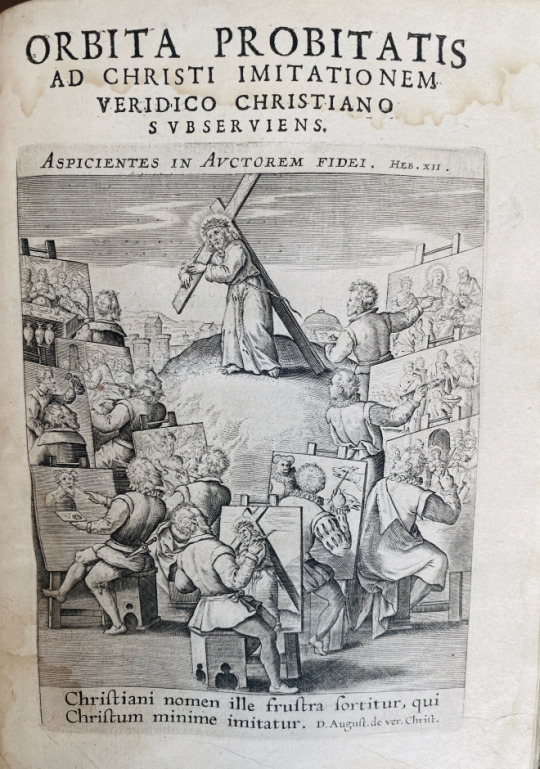
Quarto 8 1/2 X 6 inches ‡4, ‡‡4, A-Z4, a-z4, Aa-Ee4.+ 100 Numbered Plates. Withspecial engraved t.p. with allegorical depiction of Christ carrying the cross, surrounded by ten artists at easels painting scenes from his life (as well as a few questionable profane subjects).
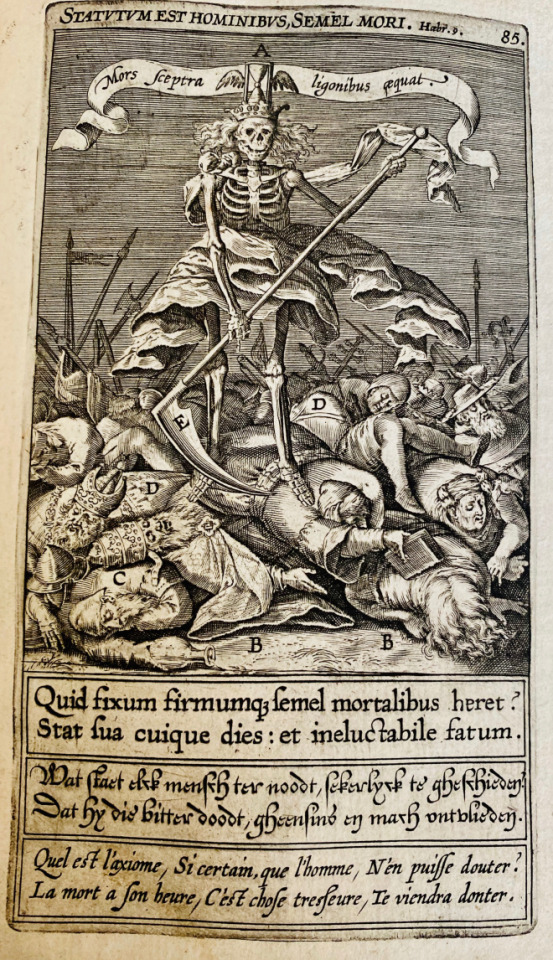
The text is divided into 100 chapters, each with an allegorical engraving incorporating letters keyed to the explanatory text and with marginal references. Each of the 100 numbered plates has a single line of Latin at the head giving the subject, with two-line explanatory verses below the allegorical engraving in Latin (roman letter), Dutch (civilité) and French (italic) First plate (following [2 daggers]4) is added title leaf for the ill., which were also published separately; see Bibliotheca Belgica. The added title reads: Icones ad Veridicvm Christianvm P. Ioannis David e Societate Iesv At the end is Device with compasses and the motto “constantia et labore” on Ee4r . This book is notoriously found defective in one way or another, this copy is perfect and complete.
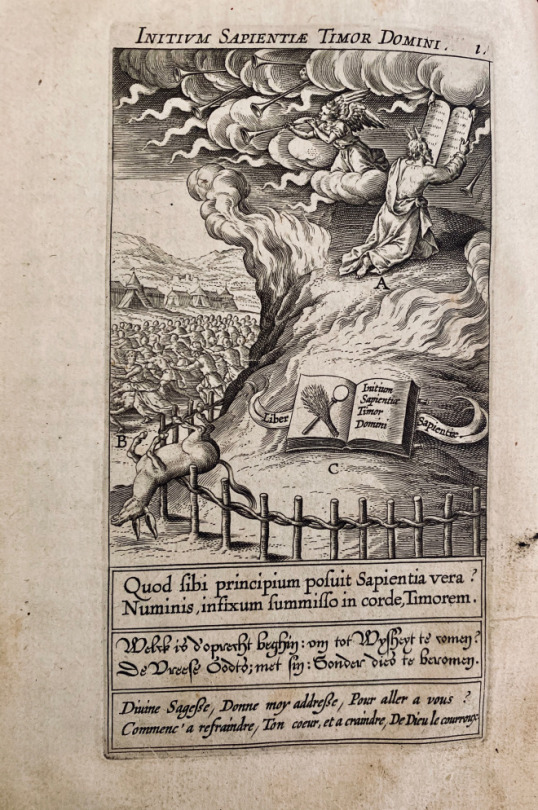
This copy is bound in full contemporary blind stamped calf over wooden boards with two working clasps.
The Veridicus christianus: is followed by the “Orbita probitatis ad Christi imitationem veridico Christano subserviens”: p. 351-374; which preceds a volvelle plate for use in locating specific passages.
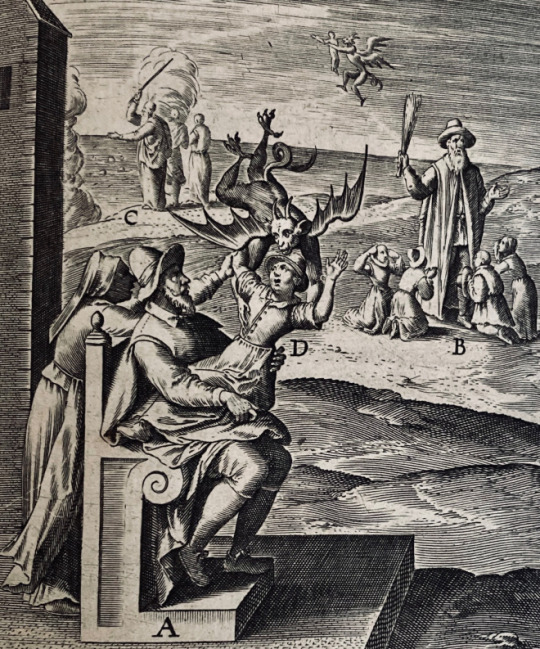
This text contains a series of images with accessible (sometimes to a fault) moral or religious messages. These illustration swarns against opening the senses to temptation lest death and moral decay take up residence in one’s soul.
The Veridicus Christianus emphasizes the Society of Jesus’ investment in thinking in, though, and about visual images that exemplify the supreme mystery of God. Published as a tool of devotion and meditations, it features one hundred chapters that encompass a wide range of topics for reflection. Each chapter incorporates an extensive commentary that interprets the emblematic image David too follows the order in which we apprehend things with our senses, beginning with a visual representation at the head of each chapter. Then comes the explication. The symboli explicatio was considered necessary because cultivated readers would be more susceptible to a reasoned argument than a picture.
Here are images of the vovell. The centers of the engraving and the volvelle (through which a string passes) are reinforced with small paper roundels printed with the monograms of Christ. The numbers are keyed to an “Indiculus orbitae” that follows (Bb1r-Bb2r). There a number, having been selected, is provided with a phrase from various Latin authors (listed on Bb2v), and a reference to one of the hundred sections that comprise the main text. It is suggested in Bibliotheca Belgica that this game may have been intended as a pious alternative to such superstitious books as Thuys der fortvnen.
)0(
4) 312J. Domenico Cavalca. (1270?-1342)
Pungi lingua
[Baptista de Tortis]: Venexia, Adi .viiii. de Octubrio. 1494 $12,000
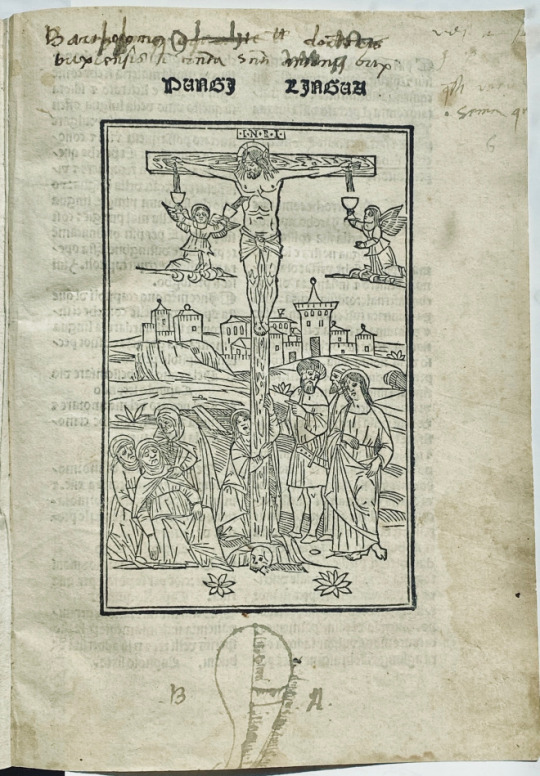
Quarto (200 x 145 mm); [80] pages. a-k8. Large woodcut depicting the crucifixion on the frontispiece, First Venetian edition with the beautiful woodblock published here for the first time. This copy has a beautiful initial “A” in gold, blue, red and green, a colorful coat of arms. This copy is bound in modern carta rustic with a gold title on an orange label

This is a treatise on the dangers of the misuse of the language it was, as you might expect quite popular . Written by the Dominican monk who was a contemporary of Dante and among the first to write in the vernacular, and one of the most successful translators of holy texts.
Aside from Biblical illustrations, the Pungilingua has many exempla drawn from many other sources including some not includes in the Alphabetum narratinum. Most of the stories are told in one to three lines, and many contain commerce with the Devil, one time disguised as a horse. In the prologue Cavalca mentions that he gathered his exempla from many sources “alcune poche cose” . One of the major sources is the Summa Vitiorum by Peraldus. but he also quite a few profane authors , Seneca, Socrates, Cicero, Valerius Maximus. That said, quite often Cavalca attributes the wrong author. Cavalca writes as though he was speaking to the reader in person useing phrases like “Io per me credo” and “Oimé “ Introducing unique stories and words, He refers to someone as double-tongued as a “tecomeco” (bilingue) . He refers to a sleight of hand trick ,called “gherminella” a word which was used later by Boccaccio. This is an important book in Italian literary history, and the Italian vocabulary leaving many contemporary proverbs and descriptions of medieval life. Goff C342; H(Add)C 4776a; R 116; Pell 3448; CIBN C-195; IGI 2637; Essling 750; Sander 1853; Pr 4649; BMC V 328; GW 6413
One copy in Goff. Huntington Library.
Queried Location: New York NY, Manhattan College: sold Christie’s (NY) 1 June 1991 lot 41 (current whereabouts unknown)

***
***
5) 350J. Richard FitzRalph (Ricardus Radulphus Armacanus pseudonym) (circa 1300-1360)
Summa Domini Armacani in Questionibus Armenorum noviter impressa et Correcta a magistro nostro Johanne Sudoris. Cum aliquibus Sermonibus eiusdem de Christi dominio.
Paris: Jehan Petit et ponset le Preux, (Venales habentur in vico divi Jacobi sub Lilio aureo) 1512. [Privilège octroyé à Jean Petit et Poncet Le Preux daté du 12 mars 1511 (1512 n. st.) et prenant effet le 15 juillet 1512.]. $24,000
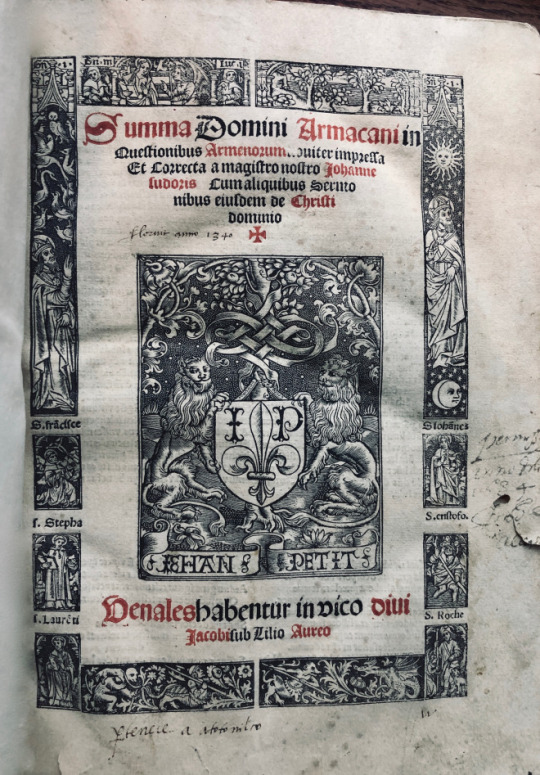
Small Folio 275 x 201 mm. A6 a-z6 &6 A-E6 F4. [6], 177 [i. e., 178] leaves. This copy is bound in a Remboîtage of later limp vellum; contents toned and brittle, lightly damp wrinkled with marginal damp staining at beginning and end, contemporary inscriptions on title and scattered underscoring and marginalia, wormhole through blank outer margin of approximately the first 30 leaves, paper crack in o1 not affecting text, last leaf reinforced in outer margin on verso. A Mexican Augustinian branded ownership mark on bottom edge. This is the only printed edition of the Summa in Questionibus Armenorum which is an examination of alleged Armenian doctrinal errors, the chief dogmatic work by an Irish theologian and prelate involved in negotiations between the papal court at Avignon and Armenian representatives over the reconciliation of the Roman and Armenian churches. FitzRalph, whose Defensorium curatorum was first published circa 1483, was one of the earliest Irish authors to appear in print. Renouard-Moreau II, 314; Shaaber M119; not in RBH or ABPC. Moreau, B. Inventaire 1512- 314; Index des livres interdits, t. IX, p. 86 (n° 50/499; Page de titre en rouge et noir dans un encadrement de plaques gravées sur métal, marque de Jean Petit (Renouard, 890) Adams, F-550
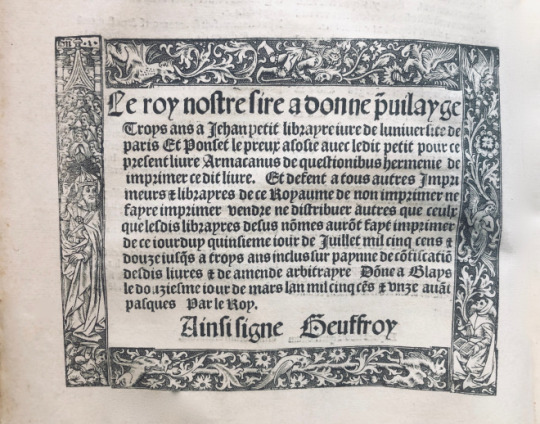

><><><><><
6) 358J Jacobus de Gruytrode 1400-1475
Speculum animae peccatricis
[Memmingen : Albrecht Kunne, about 1490] $6,500

Quarto , [28] ff, 33 lines, the first initial (5 lines) is painted in white and blue on a golden background, upper and left margin richly decorated in red, purple, blue and gold and with two red beasts. 19th c. binding in half leather, title gilt on spine, all edges gilt. Sometimes falsely attributed to Dionysius Carthusiensis, the Speculum is now attributed either to Jacobus de Gruytrode (cf. Bloomfield) or to Jacobus de Clusa (cf. L. Meier, Die Werke des Erfurter Karthäusers Jakob von Jüterbog, Münster, 1955).

Speculum animae peccatricis is a work of spiritual edification which consists of seven sections: on human misery, sin (especially lechery), penance, rejection of the world, the vanity of human wishes, death and hell and heaven.
Firste of the filthenes and miserie of man. Below are the chapter in English
Secounde of the synnes ingeneralle and of their effectis.
Thyrde howe they ought hastely with all diligence to do penaunce.
Fourth howe they ought to fle the world.
Fyfthe of the false Riches and vayne ho∣noures of the worlde.
Sixt howe they ought to drede deth.
Seuenth of the Ioyes of paradyse and of the paynes of hell.
There is no modern critical edition of the text. Among the devotional books by the Flemish mystical writers of the fourteenth and fifteenth centuries, none was more popular on the Continent and in England during the early Renaissance than the Speculum aureum animae peccatricis or The mirroure of golde for the synfull soule, which Lady Margaret Beaufort translated into English. Since the sixteenth century, bibliographers have listed the Speculum as the work of the Carthusian monk Jacobus de Gruytroede, prior of the Liége Charterhouse from 1440 to 1475, yet the English version is always attributed to his friend Denis de Leuwis or Dionysius the Carthusian, as he is better known. The question of authorship may be satisfactorily settled as the result of recent research by an English Carthusian scholar in the library of the Certosa in Farneta. He noted that the editors of Dionysius’s Opera omnia (Tournai, 1913) explain how the error in authorship began. In volume xlii they point out that, owing to the Carthusian tradition of anonymity during a monk’s lifetime, the Speculum was printed anonymously until 1495, in which year the Nuremberg printer Paul Wagner first issued it as a work by Dionysius. He found the manuscript of the Speculum in the library at Ruremond, where Dionysius was prior until his death in 1471, and supposed it was written by him, as were the other works he intended to print. The two priors were close friends, and dedicated several of their works to each other. Nugent E.M. (1969) Jacobus de Gruytroede. In: Nugent E.M. (eds) The Thought & Culture of the English Renaissance. Springer, Dordrecht
Goff S644; HC 14899*; Pell 4313; CIBN S-333; IGI 5001; IDL 2532; Schlechter-Ries 1003; Voull(B) 1617,5; Schmitt I 1614,2; Hubay(Augsburg) 1141; Hubay(Eichstätt) 538; Sack(Freiburg) 1951; Walsh 988; Bod-inc S-258; Sheppard 2032; Pr 2804; BMC II 608; BSB-Ink I-23; GW M10734
U.S. copies;Harvard ,Emory, Columbia ,Huntington Library
Southern Methodist Univ, Univ. of Illinois at Urbana-Champaign Library
)0(
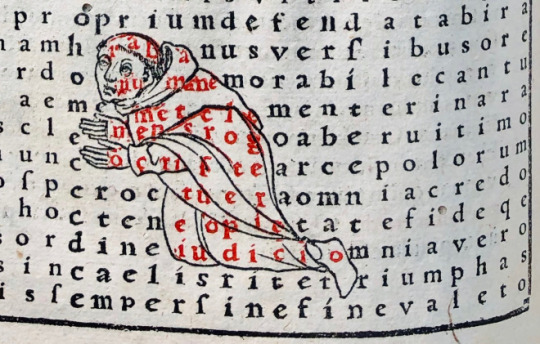
Nam digiti scripto laetantur, lumina visu Mens volvet sensu mystica verba Dei
“The fingers rejoice in writing, the eyes in seeing, and the mind at examining the meaning of God’s mystical words.”
The first printed facsimile of a manuscript.
7) 351J. Hrabanus Maurus. 784-856?
Magnencij Rabani Mauri De Laudib[us] sancte Crucis opus. erudicione versu prosaq[ue] mirificum.
Phorçheim. [Pforzheim] : In ædibus Thom[ae] Anshelmi., 1503. $10,700
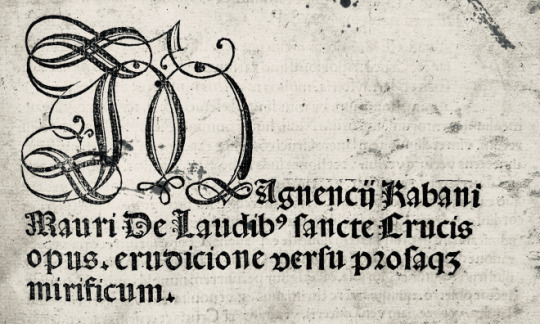
Folio Aa6, Bb4, a-k6, A-B6, C4 (last leaf blank).
THIS COPY LACKING [four leaves] A5 & 6, Bb1 and a1. [two woodcuts of Alcuin interceding on behalf of Rabanus before Pope Gregory iv, and of Rabanus presenting his poems to the Pope; and two figured dedicatory poems the first to Louis the Pious the next christ crucified] It is bound in a full vellum modern binding. First Edition (for a second edition see below) Types 3:109R, 4:180G; 40 lines of transcribed verse + headline, 40 lines of commentary + headline, red and black printing throughout, calligraphic woodcut initial (Proctor, fig. 24) M on title page, woodcut initials printed in red, and a figured prefatory poem, 28 carmina figurata, the first entirely xylographic, the remaining poems combining printed and xylographic letters with the versus intexti printed in red (except fig. xvi), enclosed by either woodcut figures (of the emperor, Christ, the Evangelists, Cherubim, etc.) printed in black or by Christian symbols and characters, most defined by metal rules in red.
This is a remarkable typographical achievement, probably the earliest attempt to reproduce a medieval manuscript. The greater portion of the work comprises a preface in verse and twenty-eight poems. “Hrabanus Maurus, the abbot of Fulda, wrote in the midst of the ‘new monasticism,’ a period associated with a revival of literacy and learning. In religious and secular spheres. This ‘script culture,’ as Rosamond McKitterick has it, used the written word not only as a mode of communication but as ‘a resource, a guide, a key, and an inspiration,’ especially in the devotional practice of Christianity.
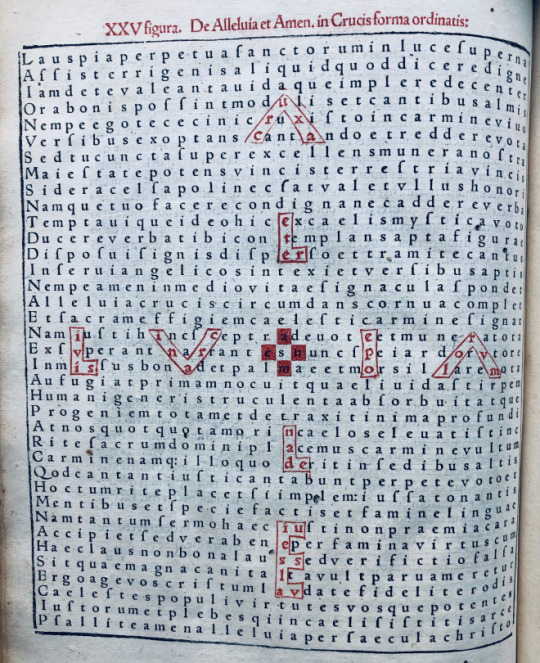
Each of the twenty-eight picture poems that form In honorem sanctae crucis explores a different theme relating to the Cross through a complex interplay of word and image. The poems each have an equal number of letters per line, written continuously like a grid. By following the letters in the usual direction for a Latin text—from left to right, top to bottom—each grid reads as one long poem. But within each grid, certain letters are also marked out with colour and drawings to form pictures. The letters that make up these pictures read as separate short poems embedded within the larger poem. As such, each page of In honorem sanctae crucis presents not just a puzzle of words and pictures, full of hidden and interrelated messages for the reader to decode bout a meditation exercise.
“Hrabanus created the various shapes and figures by highlighting individual letters in underlying poens in colour (in the printed editions red), and theses individual letters together make up meaningful text , ranging from simple declarations to very elaborate ones. For example, Carmina 2 contains a simple cross inside a square (Hrabanus calls it a “tetragonum”)whose sides form a border for the poem as a whole. The textfrom the underlying poen that makes up the figure consists of six hexameters, each one an address to the cross beginning with the words ‘O crux…’ When we follow Hrabanus’s instruction in the accompanying prose text for reading these hexameters, we find the following: even though the verse that forms the top of the square is also the opening of the underlying poem, he insists that we begin reading with the stem of the cross, from top to bottom.” (Schipper)
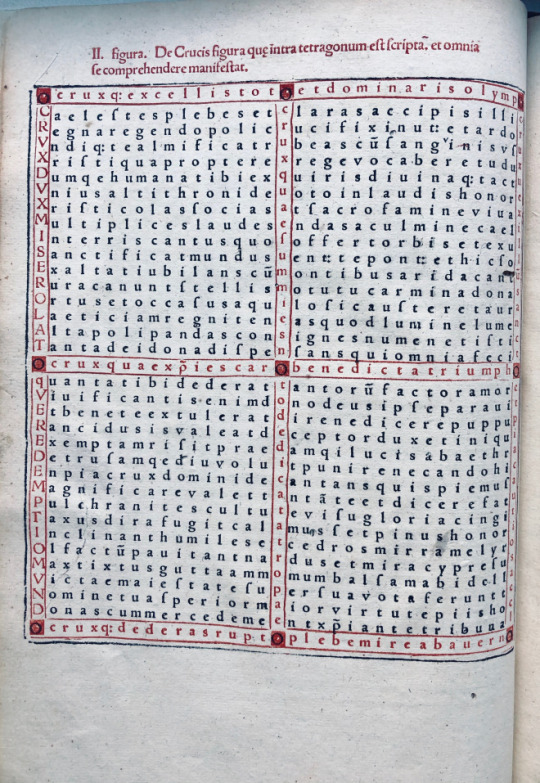
Sunt quoque uersus duo in ipsa ccruceconscripti, quorum prior est: O CRVX QVAE SVMMI ES NOTO DEDICATA TROPAEO
a summo in ima descendens. Alter uero: O CRVX QVAE CHRISTI ES CARO BENEDICTA TRIVMPHO a dextra in sinistram crucis tendens ‡
‡“there are also two verses inscribed in the cross, the first of which is : “ O cross , thou who art at the height of fame, a dedicated moment” ‘running from the top down. And a second’ “O Cross thou who through the body of Christ art the blessed triumph” ‘running from the right to the left.’
Further more Hrabanus flips left and right the texts point of view alternates , Hrabanus tells us the cross is looking out at the reader, not the other way around. “ Only after we have read the hexameters in the cross are we free to read the verses in the four sides of the tetragon, and even then Hrabanus constrains the order in which they are to be read: first the top, then the bottom, then the right side then finally the left side.”
More complex figures present further challenges in reading. The figure in Carmen 25, for example, consists of eight letters of the word ‘ALLEVIA’ arranged around a small cross. It does not take much effort to notice that we need to start with the A, read down to the E, continue on the left, and end on the right of the figure; and that each time we trace out those letters we make the sign of the cross. It becomes more difficult when we also try and read the text that is enclosed in the figures.

The letters of ALLEVIA are made of the following letters from the underlying poem. A crux[a L eter L na[de E i]es[lave[v L ivis V in]arc I e]po A lorvm
CRUX AETERNA DEI ES LAVS VIVIS IN ARCE POLORUM
‡ Eternal cross, thou art the praise of God, thou livest in the arc of the skies.

Peter Godman, Poetry of the Carolingian Renaissance (Norman: University of Oklahoma Press, 1985), 249. A. G. Rigg and G. R. Wieland, ‘A Canterbury Classbook of the Mid-eleventh Century Anglo-Saxon England 4 (1974), 113-30.
William Schipper, ‘Hrabanus Maurus in Anglo-Saxon England: In Honorem Sanctae Crucis’, in Early Medieval Studies in Memory of Patrick Wormald, ed. Stephen Baxter, Catherine Karkov, Janet L. Nelson, David Pelteret (Farnham, Surrey; Burlington, Vt.: Ashgate 2009), 283-98.
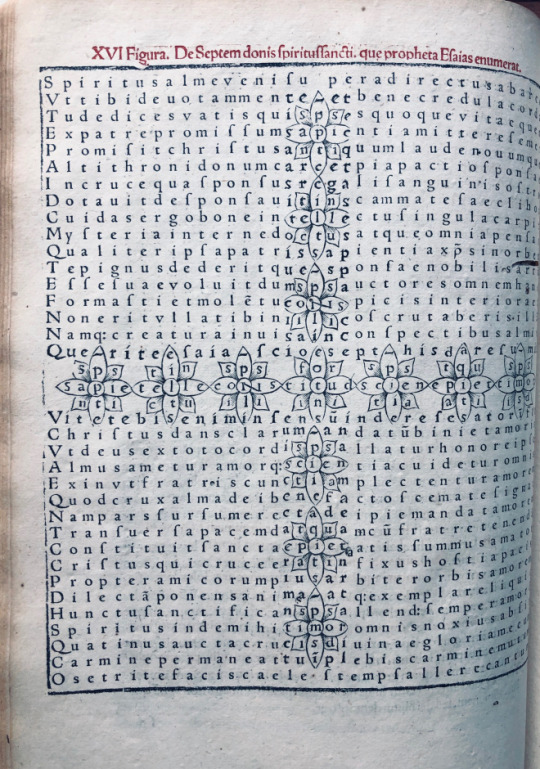
Proctor, R. Index to the early printed books in the British Museum,; 11747; Adams, H.M. Catalogue of books printed on the continent of Europe, 1501-1600, in Cambridge libraries,; R3; Catalogue of a collection of early German books in the library of C. Fairfax Murray,; 350; Panzer, G.W.F. Annales typographici,; VIII 227, 2; Pollard, A.W. Catalogue of books mostly from the presses of the first printers … collected by Rush C. Hawkins,; 189 Panzer, VIII, 227, no. 2. Proctor 11747. Fairfax Murray 350./ Last leaf blank./ Edited by Jakob Wimpheling.–cf. title page verso./ Illustrations: 2 woodcuts of the author presenting his book to the pope, and many woodcut figures (Christ, cherubs, crosses, symbols, etc.) printed on 28 pages of text. Some of the text within and near the outline figures is xylographic, the rest printed. The letters within the outlines are printed in red and may be read separately in a different sense. Printed in red and black, initials (except on t.p.) in red./ With label of Sinclair Hamilton. Peter Godman, Poetry of the Carolingian Renaissance (Norman: University of Oklahoma Press, 1985), 249. A. G. Rigg and G. R. Wieland, ‘A Canterbury Classbook of the Mid-eleventh Century Anglo-Saxon England 4 (1974), 113-30. William Schipper, ‘Hrabanus Maurus in Anglo-Saxon England: In Honorem Sanctae Crucis’, in Early Medieval Studies in Memory of Patrick Wormald, ed. Stephen Baxter, Catherine Karkov, Janet L. Nelson, David Pelteret (Farnham, Surrey; Burlington, Vt.: Ashgate,
^)^)^)^(^(^(^
The second edition One-Hundred and three years later.
8). 354J Hrabanus Maurus. 784-856?
Magnencij Rabani Mauri De Laudib[us] sancte Crucis opus. erudicione versu prosaq[ue] mirificum. Cum antiqviate avctoris <annis abhinc prope octingentis abbatis primum fuldensis, archiepiscopi postea moguntini. tum noitate scriptionis memorabile. Qvo figvris sive imaginibvs XXVIII. multi fedei christianae mysteria, multi mystici numeri; angelorum, virtutum, VII. donorum Spiritus Sancti, VIII. Beatitudinum, IV. elementorum, IV. temorum anni, VI euangelistarum & agni, mensium, ventorum, V librorum Moysis, nominis Adam, alleluia, & amen, aliarumq[ue] rerum vis & dignitas in formam crvis reedacta, subtiliter et ingeniose explicantur.
Augustæ Vindelicorvm e typographeo Praetoriano. , 1605. $9,000
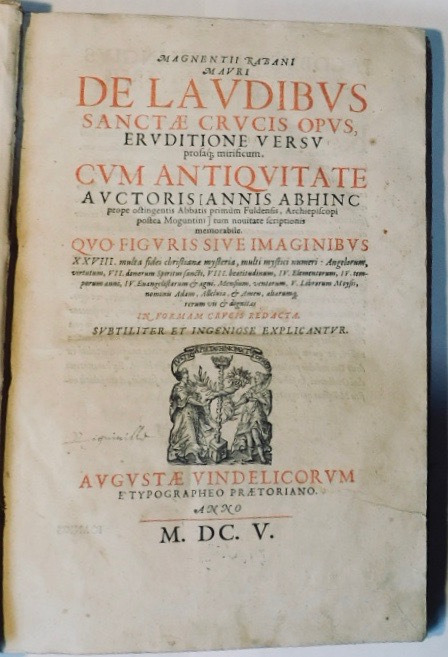
Folio Aa6, Bb4, a-k6, a6, B4, c4. (complete). Printers mark on title page, woodcut initials printed in red, two woodcuts of Alcuin interceding on behalf of Rabanus before Pope Gregory iv, and of Rabanus presenting his poems to the Pope; a figured dedicatory poem to Louis the Pious and a figured prefatory poem, 28 carmina figurata, the first entirely xylographic, the remaining poems combining printed and xylographic letters with the versus intexti printed in red (except fig. xvi), enclosed by either woodcut figures (of the emperor, Christ, the Evangelists, Cherubim, etc.) printed in black or by Christian symbols and characters, most defined by metal rules in red. Bound in contemporary deer skin.
This aside from the prologue this edition is a re-set reproduction of the first printed edition (see above)
#######+++++#######
9) 383J Johannes de Anania
Commentaria super prima et secunda parte libri quinti Decretalium. Add: Repertorium
Bologna : Henricus de Colonia, 7 Dec. 1479, 5 Jan. 1480. $17,000
Large folio 422 x 285mm Pars III (bound first) a8,b6,c10,d6,e8,f4,g8.(lacking a1Blank) Pars I (bound second) a10,b8,i8,k6,l8,m8,n6,o6,p8,q8,r10s 10. Pars II (bound third) A8,-F8,G6,H8,-L8,M6,N8,O8P6,Q8,R8,S6,T8,U10,X8-Z8, &8, ¶8,€8,¡8. In three parts, dated: 7 Dec. 1479 (Commentaria, partes I-II); 5 Jan. 1480 (Repertorium)
No copy of parts II & III in the US. The margin of a2 of the Repertorium cut off with no text loss (see image) This is a very very wide margined copy, with strong and crisp paper. The first leaf is stroked in red and blue. Throughout the rest of the books capital spaces are left blank. This copy is bound in 19th century vellum.
ANANI’A, JOHANNES DE : his family name, Anagni. implies that he was of the family of the Catani, and that his father’s name was Leonardo. He taught canon law in Bologna, and had the reputation of a conscientious man. He studied under Floriano di San Pietro. Alexander Tartagni and Andreas Barbati were his scholars; the former became his step-son, and the latter inherited his library. According to Orlandi, Anania was sent ambassador from the city of Bologna to Pope Martin V. in 1425, and he was also employed to conduct negotiations with other princes. Johannes de Anania at the time of his death, in 1455 or 1458, was archdeacon at Bologna. Spangenberg enumerates four of his works, three of which were published at Lyon between 1521 and 1555 : — 1. A Commentary on the fifth book of the Decretals, published in folio at Lyon in 1521, and reprinted there in 1553. 2. Consilia, discovered and edited by Ludovico Bolognini, in folio, at Lyon in 1555, reprinted at Venice in 1570. 3. “De Revocatione Feudi alienati,” in octavo, at Lyon, in 1546, reprinted at Basle in 1564. 4. A Collection of the Decisions of the Roman Rota, at Venice, in folio, in 1496. Mazzuchelli mentions a treatise on the law as to salaries, “Allegatio de Salario et Stipendio ac de Obligatione et Promissione Domini,” which is preserved in MS. at Bologna in the library of the Collegio di Spagna. In addition to these Lipenius ascribes to Johannes de Anania a legal tract on church patronage, “De Jure Patronatus Ecclesiastico,” published at Amsterdam in 1640; and a collection of cases (” Quaestiones”) at Cologne in 1570. To the folio edition of Baldus, “In Usus Feudorum Commentaria,”

published at Lyon in 1550, there is appended a thesis on the law regarding the alienation of fiefs, maintained by Johannes de Anania at a public disputation in Bologna. The date is not given, but he is styled “Doctor et Canonicus,” and his opponent is said to have been Secundinus de Natis; and the publisher intimates that the MS. had been preserved in the library of Johannes Nevizanus at Asti. No. 446. of the Arundel MSS. in the library of the British Museum contains a treatise “De Usuris” by Johannes de Anania. The volume is of a large folio form, and the ” De Usuris,” written in a small character with numerous contractions, occupies the folios 93. to 164. inclusive, each folio containing four columns. These treatises are the only compositions of the author we have seen, and they leave a favourable impression of his skill in selecting authorities to support and elucidate his positions, and of his talent for lucid arrangement. (Mazzuchelli, Scrittori d’ Italia; Spangenberg, in Ersch und Gruber’s Allgemeine Encyclopadie; Alidosi, Appendice alli Dottori Bolognesi de Legge Canonica e Civile; Orlandi, Notizie degli Scrittori Bolognesi; Baldus Perusinus, in Usus Feudorum Commentaria doctissima, quibus accesserunt Andr. Siculi Adnotationes una cum Joan. de Anania eleganti Disputatione in tres secta Quastiones, Lugduni, 1550, fol.; Arundel MSS. in the British Museum, No. 446.) W. W
Not in Goff: ISTC ij00250150; H 938*; Torchet 521; IGI 5245; IBE 3188; Kotvan 702; Sajó-Soltész 1881; Martín Abad J-44; Voull(B) 2735,20; Walsh 3188; BSB-Ink I-365; GW M12841
Holdings: United States Harvard University, Law School Library (I) only.

)0(
)0(
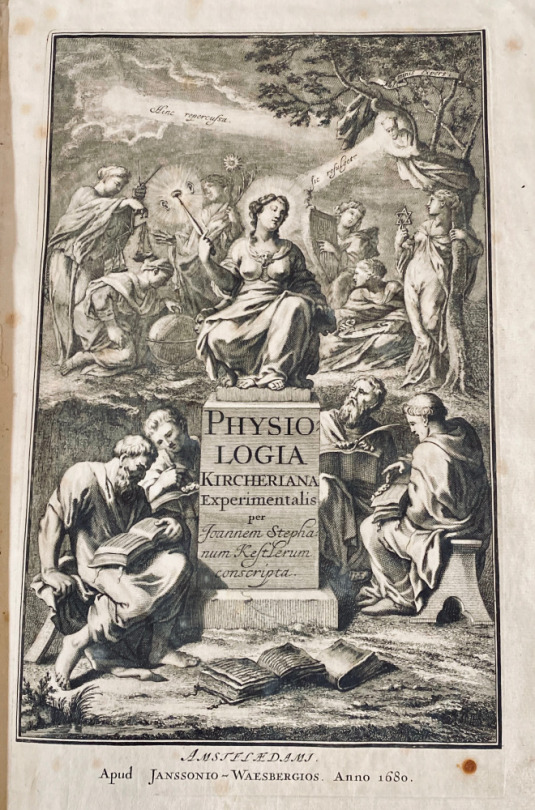
10) 381J Athanasius Kircher 1602-1680
Physiologia Kircheriana Experimentalis, Qua Summa Argumentorum Multitudine & Varietate Naturalium rerum scientia per experimenta Physica, Mathematica, Medica, Chymica, Musica, Magnetica, Mechanica comprobatur atque stabilitur. Quam Ex Vastis Operibus Adm. Revdi. P. Athanasii Kircheri extraxit, & in hunc ordinem per classes redegit Romæ, Anno M. DC. LXXV. Joannes Stephanus Kestlerus Alsata, Authoris discipulus, & in re litterariâ assecla, & coadjutor.
Amsterdam: Ex Officinâ Janssonio-Waesbergiana. Anno 1680 $9,500

Folio. 15 x 9 3/4 inches. *4, A-Z4, Aa-Ii4. First edition.mmThis copy is quite clean and crisp throughout, never having been washed or pressed. There is some occasional spotting and browning. but none is too extensive. The binding is twentyth century full vellum with title on spine. an impressive and large copy!
“Thus in the must varied branches of science Kircher played the role of pioneer. Even medicine received his attention, as is shown for example by his treatise, ‘Scrutinium phyisco-medicum contagiosæ luis, quæ pestis dicitur’ (Rome, 1663). His scientific activities brought him into scientific correspondence with scholars laboring in the most different fields, as the numerous volumes of his extant letters show. It is to his inventive mind that we owe one of the earliest of our counting machines: the speaking-tube and æolian harp were perfected by him. He was also the inventor of the magic lantern which has since been brought to such perfection and is and is today almost indispensable. [All of these devices are illustrated in the present work, compiled in the year of the author’s death by Kircher and his student Johann Stephan Kestler, including three large and striking engravings of magic lanterns.]” May I ask the reader to take the following quote with a measure of indulgence for its closed minded author [circa 1913] with the hope that modern folk of the last decade of the second millennium have a bit more tolerance for the many sciences that we have yet to master. “That the most varied judgments should be formed and expressed on a man of such encyclopædic knowledge was only to be expected. He tried to find a grain of truth even in the false sciences of alchemy, astrology, and horoscopy, which were still in his time much in vogue, nor is it surprising that in the province of astronomy he did not at this early date defend the Copernican System.” (the above two quoted taken from the Catholic Encyclopedia, vol. viii, page 662) Kircher was an accomplished and versatile scholar who applied his intellectual abilities to a myriad of scientific problems. This work is a fascinating compendium of scientific experiments and principles which documents the accomplishments of early modern thinkers of the west.
^)^)^)^(^(^(^
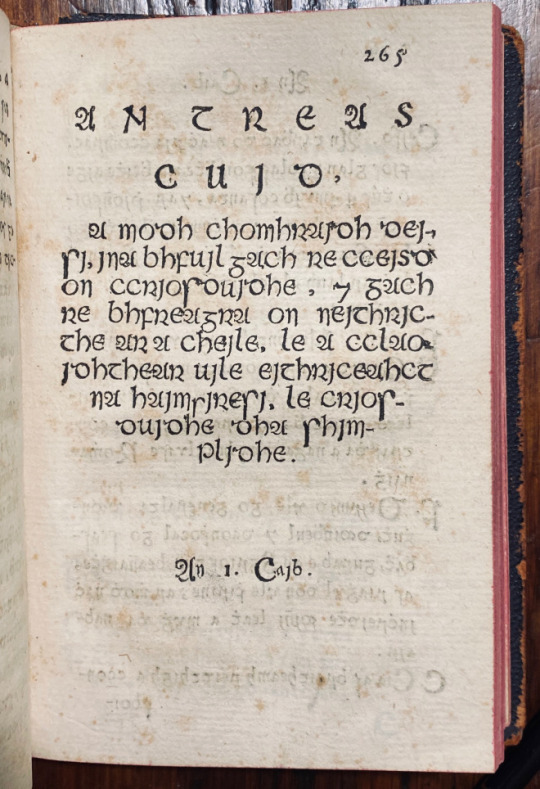
11) 380J Francis Molloy. fl 1660
Lucerna fidelium, seu, Fasciculus decerptus ab authoribus magis versatis, qui tractarunt de doctrina Christiana : divisus in tres partes.
Romæ : Typis Sacræ Congreg. de Propaganda Fide, M DC LXXVI [1676] $4,500 Octavo 6 X 4 inches : A-2B8 2C2. complet, signature ) is mis-signed . This copy is bound in early 20th century sheep.
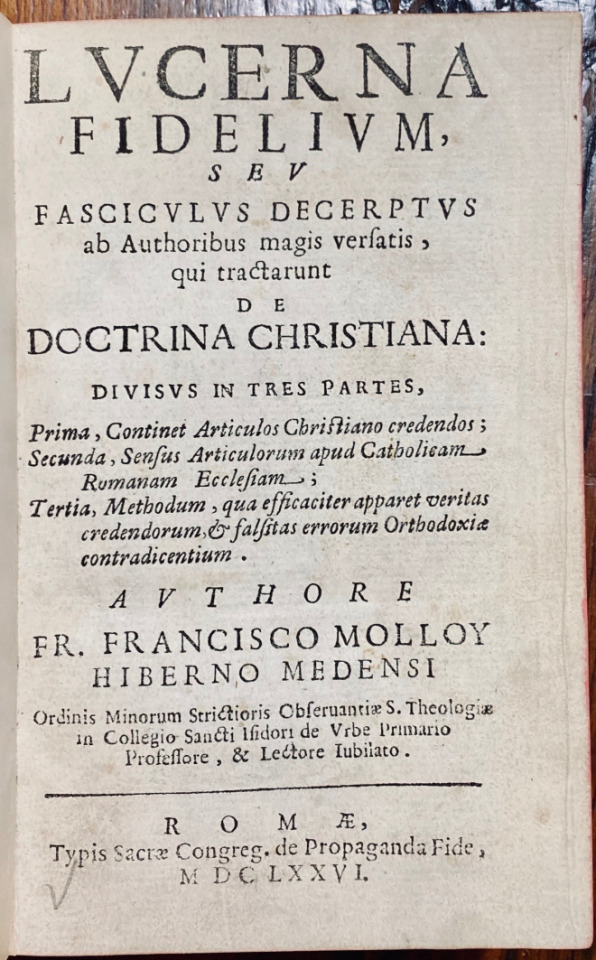
MOLLOY or O’MAOLMHUAIDH, FRANCIS (Jl. 1660), theologian and grammarian, was a native of the county of Meath, Ireland. The family of which he was a member had extensive landed possessions in the district known as O’Molloys’ Country, and some of them engaged actively in the Irish movements from 1641 to 1652.
Francis Molloy entered the order of St. Francis, became a priest, was appointed professor of theology at St. Isidore’s College, Rome, and acted as agent for the Irish catholics at the papal court in the reign of Charles II. His first published work was entitled ‘Tractatus de Incarnatione ad mentern Scoti,’ 1645. This was followed in 1658 by ‘ Jubilatia genethliaca

in honorem Prosperi Balthasaris Philippi, Hispani principis, carmine,’ and by a Latin treatise on theology in 1666.
A catechism of the doctrines of the catholic church in the Irish language was published by Molloy in 1676 with the title: ‘Lucerna tidelium, seu fasciculus decerptus ab authoribus magis versatis qui tractarunt de doctrina Christiana.’ It was printed at Rome at the press of the Congregation ‘de propaganda fide,’ ( This book is the first book they printed in Irish Type) from which, in 1677, issued another book by Molloy, entitled ‘Grammatica Latino-Hibernica,’ 12mo, the first printed grammar of the Irish language. Edward Lhuyd [q. v.], in his’ Archaeologia Britannica,’published at Oxford in 1707, mentioned that he had seen a manuscript grammar of the Irish language copied at Louvain in 1669 which partially corresponded with that of Molloy. He added that Molloy’s grammar, although the most complete exta’nt in his time, was deficient as to syntax and the variation of the nouns and verbs. The date of Molloy’s death has not been ascertained. In 1626 Propaganda Fide had installed a printing press for the foreign missions and not much later another one was brought to Louvain where books and catechisms were printed for both the local college and the Irish mission.* The problem with the Propaganda printing press was that only books in Latin and Italian were allowed to be printed so it took until 1674 when Francis Molloy asked for permission to print a catechism there in Irish with the explanation “che altra malamente capisce e vacilla assai per mancanza d’intruttore e d’intruttion sana.”**.
[“Irish priests at Rome had a new Irish type cut about 1675 … [this was] their first book.”- -H. Reichner, Catalogue 34, Jan. 1968]
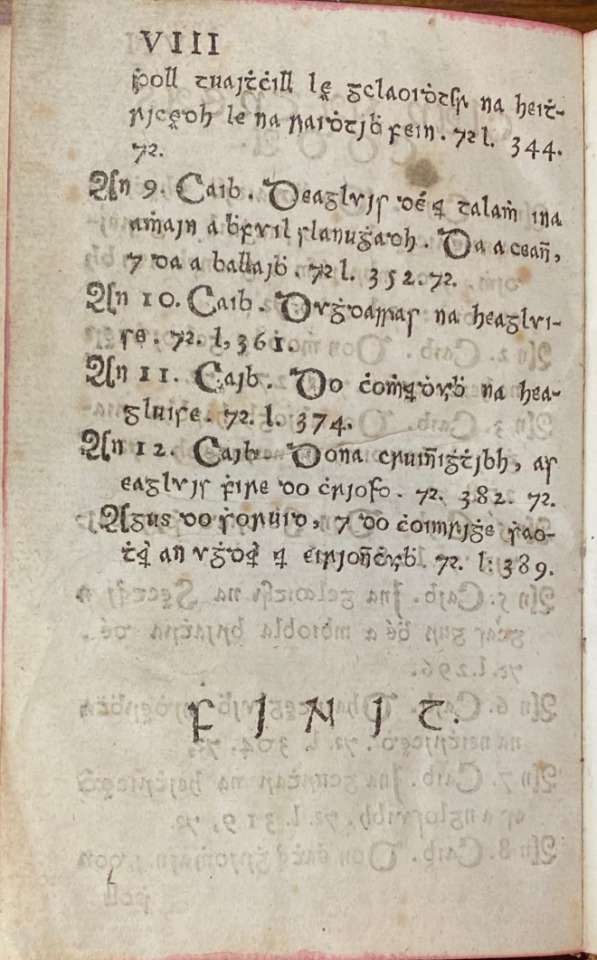
Wing O291C, English short title catalogue,; R41480; Clancy, T.H. English Catholic books, 1641-1700 (rev. ed.),; entry 743; Catalogue of seventeenth century Italian books in the British Library,; page 628 *& ** ;Egan, Bartholomew (ed.): Notes on Propaganda Fide Printing Press and Correspondence concerning Francis Molloy O.F.M., in: Collectanea Hibernica, No. 2 (1959), pp. 115-124.
)0(
)0()0(
With a reference to the invention of printing on the verso of Folio 64.
12) 359J Werner Rolewinck 1425-1502
Fasciculus temporu[m] omnes antiquo[rum] chronicas strictim complectens felici numine incipit. Prologus.
Venice : Erhard Ratdolt, 8 Sept. 1485 $16,000
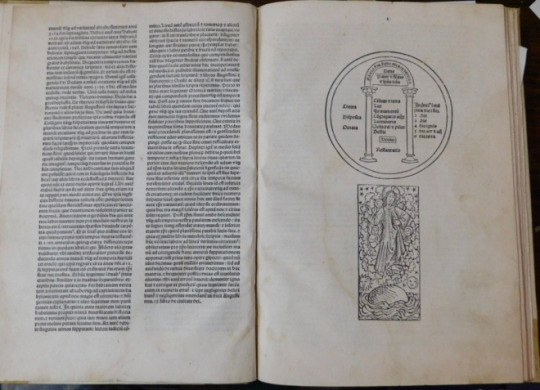
Folio (275 x 195 mm). [A]8 [a-g]8 [h]10 75 leaves without signatures or page numbers (9 leaves, 1-66 foliated ), 3 columns in table, 59 lines and foliation, gothic letter, 2 large ornamental initials, 59 woodcuts, one full-page, woodcut diagram. Fifth and last Venetian edition, and fourth Ratdolt edition being the most complete edition of Rolewinck s chronological history of the world. The chronology follows a double time-line, measuring time from both the Creation and the birth of Christ to the death of the Ottoman Sultan Mehmed II commonly known as Mehmed the Conqueror in the year 1481, demanding a
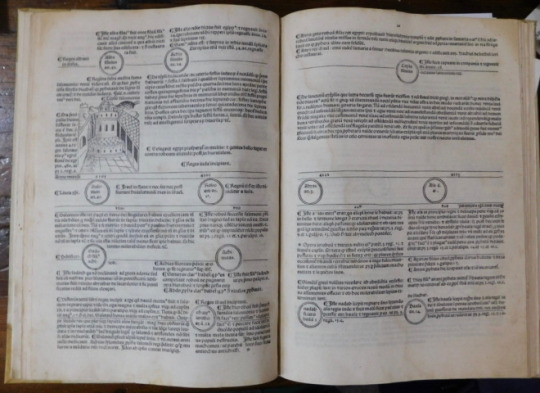
remarkably complex typographical layout. The Fasciculus Temporum (Little bundles of time) was the first book printed on history of the world, it is also one of the earliest and greatest of illustrated incunabula. The illustrations show Noah s Ark, the tower of Babel and contain many town views including Jerusalem, Syracuse, Rome and the Doge s Palace in Venice.
Rolewinck (1425-1502) was a Carthusian monk and prolific author. This book was both the most popular of his numerous writings and the most popular concise world chronicle of its time, being printed 32 times in the 15th century, including translations into French, German and Dutch . Rolewinck’s Fasciculus Temporum was an enormously popular world chronicle, appearing in over 30 incunabular editions in Latin, German, French, and Dutch. A very handsome and typographically-sophisticated volume, with varying columns, circular devices with inset type, and woodcuts throughout.
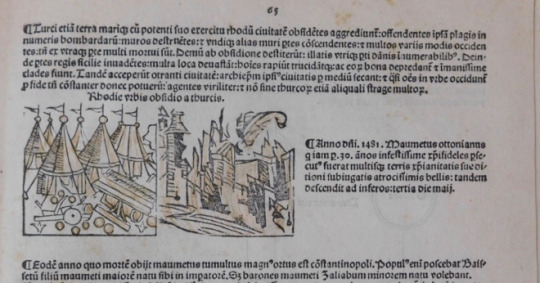
This work aspires to trace the history of the world from the beginning of time until the year of pulication. The thirty-three woodcuts are crisp and rather charming, and, like those in many fifteenth- and sixteenth-century chronicles, are occasionally reused to illustrate different events and locations. The work is fascinating for the comprehensiveness of its content as well as the beauty of its execution. Of particular interest is a reference to the invention of printing (in 1454) on the verso of Folio 64.

Goff R271; GW M38738; ; BMC V 290; H 6935*; Redgr 52; Essling 280; Sander 6530; Schr 5116C; Pell Ms 10192 (9969); CIBN R-177; Arnoult 1276; Neveu 528; Nice 269; Torchet 821; Polain(B) 4691; IDL 3943; IBE 4955; IGI 8420; CCIR R-40; Kotvan 1024; Sajó-Soltész 2972; Gspan-Badalić 590; IBPort 1576; Mendes 1124, 1125, 1126; Madsen 3526; Martín Abad R-48; Voull(B) 3801; Hubay(Augsburg) 1811; Hubay(Eichstätt) 898; Walsh 1830; Rhodes(Oxford Colleges) 1525; Bod-inc R-121; Sheppard 3688; Pr 4404; BSB-Ink R-247
#######+++++#######
13) 367J Petrus de Rosenheim. (1380-1432). Nom probable : Petrus Wiechs
[Roseum memoriale divinorum eloquiorum]
[Köln] : [Southern Germany : n.pr., about 1480-90?] or [Cologne? : n.pr., about 1483] or [Ludwig von Renchen?], 1483. $12,000

Quarto (190 x 155 mm). Collation: a-f8 [1-68]. [48] leaves. First Edition. Text in one column, 32 lines. Type: 80G. Initials painted in red, and blue ink throughout. Simple vellum binding from a 15th century vellum leaf. Gothic script. . A very good copy, old repair to the first blank leaf, a few spots, pale stain at the lower blank corner of the first quires. It is not known where and by which press this edition was printed. ISTC gives Southern Germany and a date of c.1480-1490, GW tentatively suggests Oberrhein, 1483, and Proctor attributes it to Ludwig Von Renchen in Cologne. The hexameters of each section of the summary form an acrostic of the letters of the alphabet. (alphabetarium) as to insure memorization in the proper sequence, the first word of each verse falls neatly into alphabetical order. [1,194 short mnemonic verses] It uses characteristic couplets (distiches) to express the main content of all chapters of the Old and New Testament. This introduction makes it possible to easily find every quote in the Bible.

A significant record of the essential role of memory in late-medieval piety, One of the earliest printed books on the ars memorativa or mnemotechnic was composed by the German Benedictine monk Petrus of Rosenhaym (Upper Bavaria), written between 1423 and 1426 for Cardinal Giulio Branda di Castiglione. Petrus of Rosenhaym composed numerous treatises, sermons, and verses: the Roseum memoriale is surely his most famous work, enjoying wide popularity during the fifteenth century and first half of the sixteenth century. The mnemotechnic method here employed is extremely complex: the hexameters of each section of the summary form an acrostic of the letters of the alphabet. in. A highly popular and broadly used manual, its copies could be found in almost every European church after the invention of the printing press it was printed in several different locations. This early medieval incunable has not been clearly dated| researchers attribute it to the Upper Rhine region sometime between 1480 and 1483. After studying at the University of Vienna, Petrus de Rosenhaym, along with his friend Nikolaus Seyringer, moved to Subiaco, where he entered the Benedectine order. In 1413, he was appointed prior to the cloister of Rocca di Mondragone near Capua. In 1416, he took part in the Council of Konstanz, and later he was prior in Melk (Lower Austria). After 1423, he was appointed ‘cursor biblicus’ and ‘magister studentium’. Goff R336; BMC I 312; ; GW M32724; ISTC; ir00336000; Polain(B) 3128; IBE 4559; IGI 7668; IBP 4380; Sajó-Soltész 2676; Madsen 3549; Borm 2134; Hubay(Würzburg) 1704; AmBCat 199; Walsh 492; Oates 867; Pr 1517;; BSB P-362; Van der Haegen II,2:16,4?; Young 278;.
Copies in the United States of America: Brown, Harvard, Library of Congress, Huntington, The Newberry Library, Yale
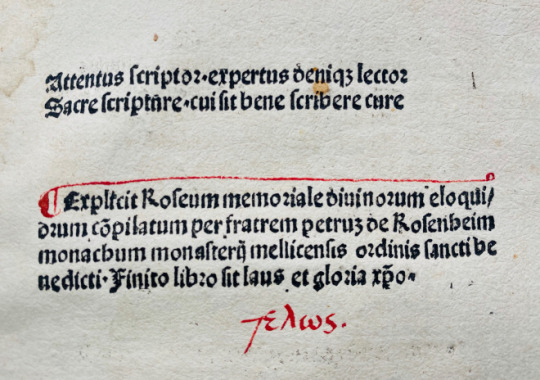
^)^)^)^(^(^(^
^)^)^)^(^(^(^

14) 384J Raymundus de Sabunde -1436
Theologia naturalis, sive, Liber creaturarum : specialiter de homine et de natura eius inquantum homo, et de his que sunt ei necessaria ad cognoscendum seipsum [et] deum et omne debitu[m] ad quod homo tenetur et obligat[ur] tam deo quam p[ro]ximo.
Straßburg: Martin Flach, 21 January 1496. $17,000
Imp[re]ssus Argentine per Martinum Flach inibi co[n]ciuem anno incarnat[i]o[n]is d[omi]nice Millesimoq[ua]dringentesimononagesimosexto men[sis] v[er]o Ianuarij die vicesimop[ri]mo
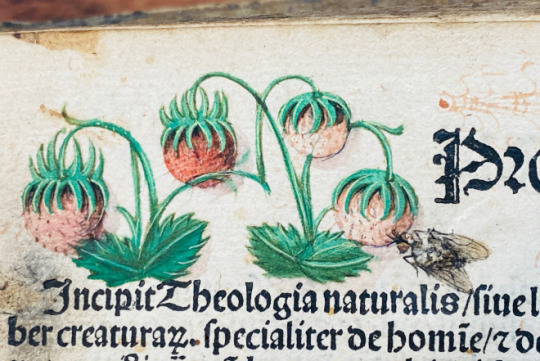
Folio (280 x 200mm.) π6 a8 b-y6 z8 [et]6 [con]8 (the last leaf supplied from another copy, printed on recto only), The second leaf (π2) has a beautiful a green painted initial A [Amor] on a gold ground with pink and blue edges, extending into the margins with green-stemmed pink and gold flowers on opposite side. The first leaf of the text proper (a1) Has a large blue painted initial A on a gold ground with pink and green edges, large pink and purple flowers, strawberries thistles and a Tromp l’oeil of a Dead fly,( quite charming) fill uppermargin; 3-line initials in alternating red and blue, rubricated throughout. This is the first dated edition.
It is bound in Contemporary deerskin over wooden boards, covers panelled and tooled in blind with repeated small rosette tool, remains of paper labels on spine (lacking metal furniture and clasps, some wear and small areas of loss). This copy has some contemporary manuscript notes, including a two-line note on f. b2recto, and on f.a2verso is a marginal drawing of the scala naturae with the four gradus marked. Provenance: Contemporary inscription of Johannes Pengl (Penngl) from Weißenburg in Bavaria, who was active in Eichstätt & Vienna, with a note of cost of binding on final paste down. Later notes and shelf-mark on front paste-down and loose sheet.
Colophon: Finit liber creatura[rum] seu nature siue nature siue de ho[m]i[n]e p[ro]pt[er] que[m] alie creature facte su[n]t ex cui[us] cognit[i]one illu[m]inat[ur] ho[mo] i[n] [co]gnit[i]o[n]e dei [et] creaturarum.
This text marks the dawn of a knowledge based on Scripture and REASON.
The Catholic Encyclopedia sees this as “It represents a phase of decadent Scholasticism, and is a defense of a point of view which is subversive of the fundamental principle of the Scholastic method. The Schoolmen of the thirteenth century, while holding that there can be no contradiction between theology and philosophy, maintain that the two sciences are distinct. Raymond breaks down the distinction by teaching a kind of theosophy, the doctrine, namely that, as man is a connecting link between the natural and the supernatural, it is possible by a study of human nature to arrive at a knowledge even of the most profound mysteries of Faith. The tendency of his thought is similar to that of the rationalistic theosophy of Raymond Lully….Moreover, in Spain scholastics, in combating Islam, borrowed the weapons of their erudite antagonists. Close internal resemblance indicates that Raimund de Sabunde was preceded in method and object by Raymund Lully.” CE

What is new and epoch-making is not the material but the method; not of circumscribing religion within the limits of reason, but, by logical collation, of elevating the same upon the basis of natural truth to a science accessible and convincing to all. He recognizes two sources of (1)knowledge, the book of nature and (2) the Bible. The first is universal and direct, the other serves partly to instruct man the better to understand nature, and partly to reveal new truths, not accessible to the natural understanding, but once revealed by God made apprehensible by natural reason. The book of nature, the contents of which are manifested through sense experience and self-consciousness, can no more be falsified than the Bible and may serve as an exhaustive source of knowledge; but through the fall of man it was rendered obscure, so that it became incapable of guiding to the real wisdom of salvation. However, the Bible as well as illumination from above, not in conflict with nature, enables one to reach the correct explanation and application of natural things and self. Hence, his book of nature as a human supplement to the divine Word is to be the basic knowledge of man, because it subtends the doctrines of Scripture with the immovable foundations of self-knowledge, and therefore plants the revealed truths upon the rational ground of universal human perception, internal and external.
The first part presents analytically the facts of nature in ascending scale to man, the
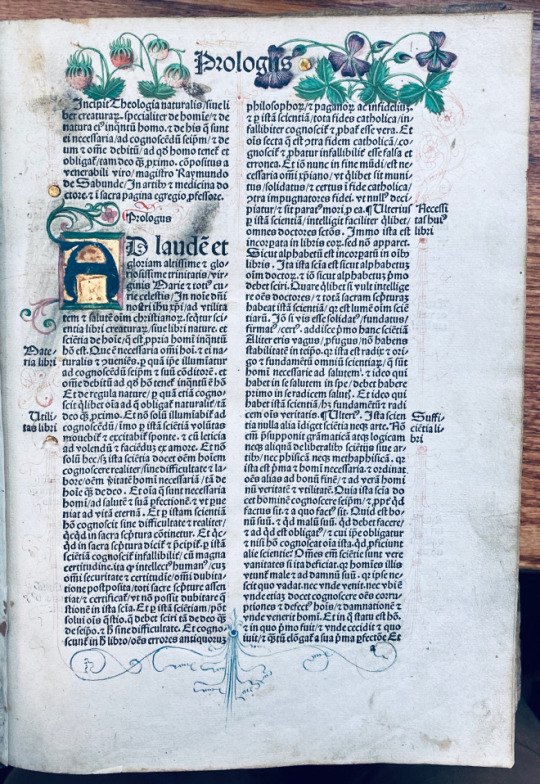
climax; the second, the harmonization of these with Christian doctrine and their fulfillment in the same. Nature in its. four stages of mere being, mere life, sensible consciousness, and self-consciousness, is crowned by man, who is not only the microcosm but the image of God. Nature points toward a supernatural creator possessing in himself in perfection all properties of the things created out of nothing (the cornerstone of natural theology ever after). Foremost is the ontological argument of Ansehn, followed by the physico-theological, psychological, and moral. He demonstrates the Trinity by analogy from rational grounds, and finally ascribes to man in view of his conscious elevation over things a spontaneous gratitude to God. Love is transformed into the object of its affection; and love to God brings man, and with him the universe estranged by sin, into harmony and unity with him. In this he betrays his mystical antecedents. Proceeding in the second part from this general postulation to its results for positive Christianity, he finds justified by reason all the historic facts of revealed religion, such as the person and works of Christ, as well as the infallibility of the Church and the Scriptures; and the necessity by rational proof of all the sacraments and practices of the Church and of the pope. It should be added that Raimund’s analysis of nature and self-knowledge is not thoroughgoing and his application is far from consistent. He does not transplant himself to the standpoint of the unbeliever, but rather executes an apology on the part of a consciousness already Christian, thus assuming conclusions in advance that should grow only out of his premises. Yet his is a long step from the barren speculation of scholasticism, and marks the dawn of a knowledge based on Scripture and reason.
In its day, and for a long time later, it was a celebrated text. The title translates ‘Natural Theology or the book of [living] creatures, in particular about man and his nature inso far as he is man, and about those things necessary for him to know both himself and God, and about every duty by which man is held and obligated both in respect of God and his neighbour.’ The scope is therefore pretty wide. The main point of Sebond’s work is that that faith can be taught, attained, understood by natural reason and not simply on the basis of blind faith and literal adherence to Scripture, although this last is given full weight as is the teaching of ‘sacrosancta romana ecclesia who is the mother of all faithful christians, mistress of grace and faith and rule of truth…’ (preface on a2ra). The work is divided into 330 ‘tituli’ or chapters beginning with the origins of natural theology and ending with the last judgement, the subjects treated at greatest length being ‘God’ and ‘Man’.
Theologia Naturalis, which circulated widely in manuscript and is known particularly in a manuscript in Toulouse (747) corrected after the author’s own copy, was first published in what is called the ‘third family’ in Deventer in 1484-85 (possibly through the offices of the Brothers of the Common Life; the Bodleian copy is from their house at Doesburg, Holland), and then Lyon ca. 1488 from the printer Balsarin. This Flach printing circulated widely (a copy was at Winchcomb abbey in Gloucestershire within a few years (now in Glasgow) and early in the 16the century Archbishop Warham (Abp. 1503-32 ) gave a copy to All Souls College, Oxford) and is the first dated edition. There were a number of later editions (including another Flach edition of 1501) right up into the 17th century. Indeed the well-known 17th-century philosopher Kenelm Digby ( 1603-1664) had a copy of this edition (now at Durham University Library at Bamburgh Castle). Part of the Theologia (Dialogos de la naturaleza delhombre) was translated into Spanish and printed in Madrid in 1610 and 1616, and a resumé by the Carthusian Petrus Dorlandus (Viola anime per modum dyalogi) was published in Cologne in 1499 (ISTC id00360000 ) and in Toulouse in 1500 I(ISTC id003610000).. The Theologia because of the importance it accorded human reason did not escape the notice of the holy Office and was placed on the Index in the middle of the 16th century. Montaigne indeed discovered this during his visit to Rome.
Goff R33.; BMC I, 154.; HC 14069*; GW M36911; Bod-inc R-018. ISTC ir00033000. Palau 283900
◊
◊ ◊
◊
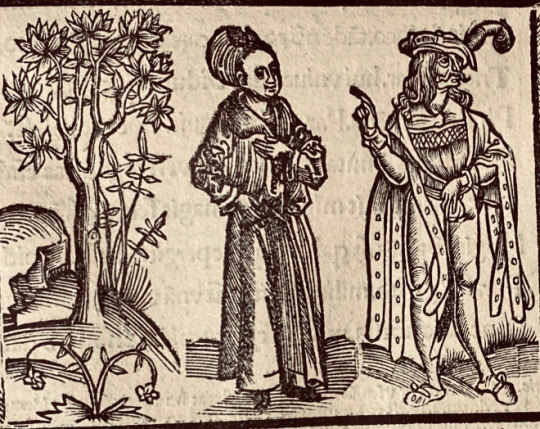
15) 369J Publius Terentius Afer. 185-
Terentius Comico Carmine
Impressum in nobili Helvecior[um] urbe Arge[n]tina : Per Ioanne[m] Grüninger mira etium arte ac diligentia. 1503 $7,500
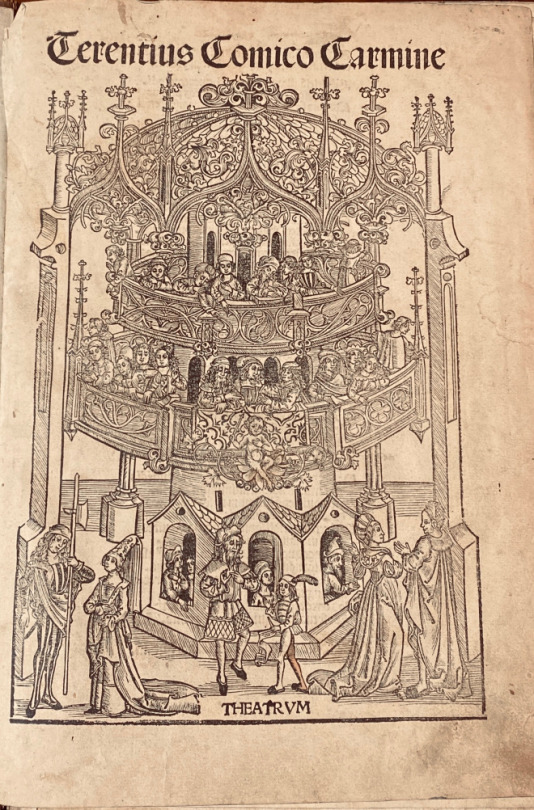
Folio A6 B8 C-Z6 AA6 Bb4 Cc6. There are numerous handwritten annotations in ink (marginal and interlinear, ff. IX-XIX). The binding of half-calf with corners of the XIXth, back with 4 sewing support with pieces of title of red and green leather, boards covered with stony marbled paper. { A typical Kloss binding} (there is a tear sig. B1, with loss; first signature cut shorter at the lower margin; restorations of paper with the last sheets in the upper margin; Yet this copy remains a beautiful illustrated edition of the comedies of Terence with comments by Aelius Donatus and Calphurnius. From the presses of the famous and prolific Strasbourg printer-publisher Johann Reinhard, known as Grüninger, it is remarkably illustrated with 7 large full-page woods (including the famous representation of a theater on the title),
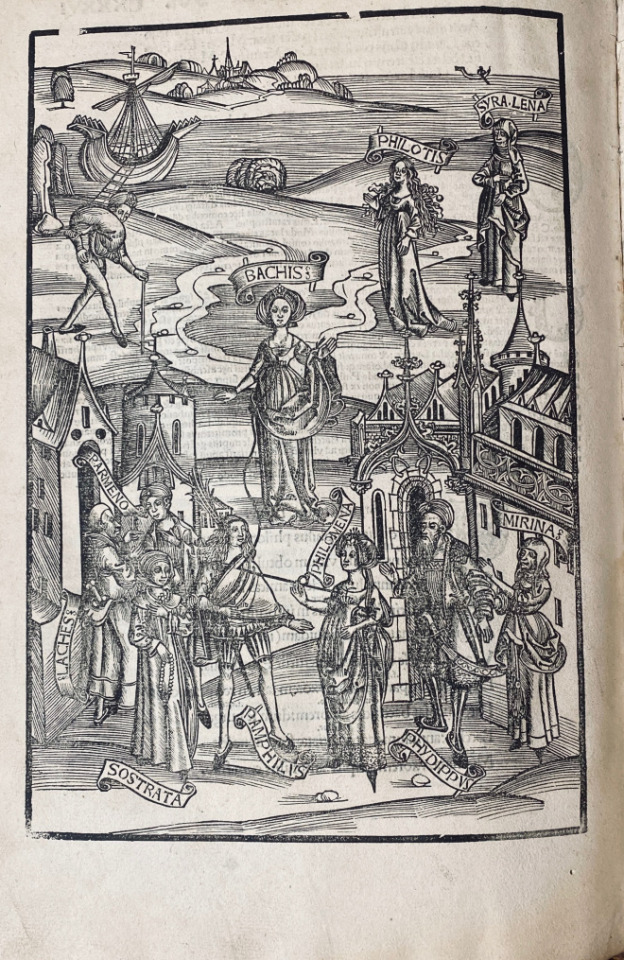
woodcuts depicting the dramatis personae in a land- or cityscape, one at the beginning of each play, and 142 woods in the text 19 of the cuts appear here for the first time; the others are from the 1496 ed. «Grüninger’s illustrations, intended to clarify the complexities of Terence’s plots for the reader, act as visual mnemonic devices for the book’s anticipated student audience. This is demonstrated especially in the full-page woodcut that begins each play, where all of the characters are displayed with connecting lines to indicate their interrelationships. covered with stony marbled paper. { A typical Kloss binding} (there is a tear sig. B1, with loss; first signature cut shorter at the lower margin; restorations of paper with the last sheets in the upper margin; Yet this copy remains a beautiful illustrated edition of the comedies of Terence with comments by Aelius Donatus and Calphurnius. From the presses of the famous and prolific Strasbourg printer-publisher Johann Reinhard, known as Grüninger, it is remarkably illustrated with 7 large full-page woods (including the famous representation of a theater on the title), woodcuts depicting the dramatis personae in a land- or cityscape, one at the beginning of each play, and 142 woods in the text 19 of the cuts appear here for the first time; the others are from the 1496 ed.

«Grüninger’s illustrations, intended to clarify the complexities of Terence’s plots for the reader, act as visual mnemonic devices for the book’s anticipated student audience. This is demonstrated especially in the full-page woodcut that begins each play, where all of the characters are displayed with connecting lines to indicate their interrelationships. A verbal explanation and plot summary accompanies each of these illustrations. The most remarkable feature of Grüninger’s Terence is his use of small interchangeable woodcuts that were combined to create the individual scene illustrations for each play. Individual blocks were cut for most of the characters of the six plays, who are identified by name in overhead banners. The blocks were cleverly combined repeatedly in groups of two to five, sometimes together with cuts of trees and buildings, to create the illustrations. Grüninger was attempting to use the woodcuts as repeatable and combinable objects, much in the same manner as movable type» (Christine Ruggere, in Vision of a Collector: The Lessing J. Rosenwald Collection in the Library of Congress)
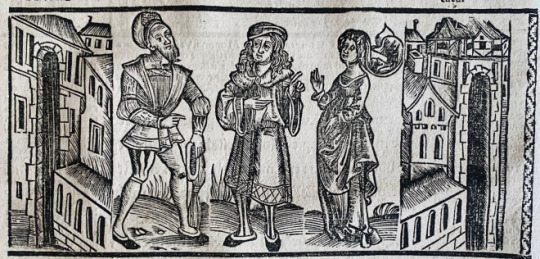
Terence writes in a simple conversational Latin, pleasant and direct. Due to his clear and entertaining language, Terence’s works were heavily used by monasteries and convents during the Middle Ages and The Renaissance. Scribes often learned Latin through the meticulous copying of Terence’s texts. Priests and nuns often learned to speak Latin through reenactment of Terence’s plays, thereby learning both Latin and Gregorian chants. Although Terence’s plays often dealt with pagan material, the quality of his language promoted the copying and preserving of his text by the church. The preservation of Terence through the church enabled his work to influence much of later Western drama. [Holloway, Julia Bolton (1993). Sweet New Style: Brunetto Latino, Dante Alighieri, Geoffrey Chaucer, Essays, 1981-2005.] This copy has the book plate and a binding typical for Kloss. It is NOT Melanchthon’s copy, or his notes!
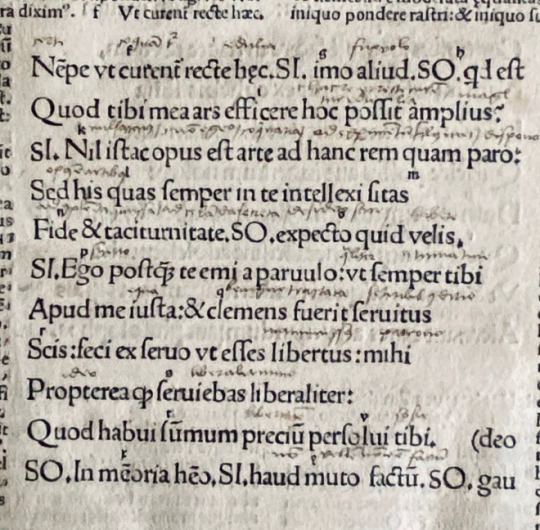
Georg Franz Burkhard Kloss (31 July 1787 Frankfurt am Main – 10 February 1854 Frankfurt). Kloss was the son of a physician and studied medicine at Heidelberg and Göttingen, where he became one of the cofounders of the Corps Hannovera Göttingen. He practiced medicine in Frankfurt. He became a book collector, and gathered a fine collection of old manuscripts,. On February 21, 1838, New York book auction house Cooley & Bangs began a three day sale during which they offered more than 313 incunabula distributed among 1,302 lots. Many incunables came from the collection of George Kloss and had appeared in the London sale of his books three years before. It is entirely possible that the 1838 sale was the first time in America that so many incunables were offered all at once in a single auction..
The bulk of the Kloss books were sold by Sotheby in 1835. Most of the books containing notes were attributed as owned and annotated by Melanchthon .
Catalogue of the library of Dr. Kloss of Franckfort a. M. including many original and unpublished manuscripts, and printed books with ms. annotations, by Philip Melancthon …Which will be sold by auction, by Mr. Sotheby and son … May 7th, and nineteen following days (Sundays excepted) .
https://babel.hathitrust.org/cgi/pt?id=hvd.32044055066971&view=1up&seq=9
Adams D 304. Proctor 9889. Ritter 2284.
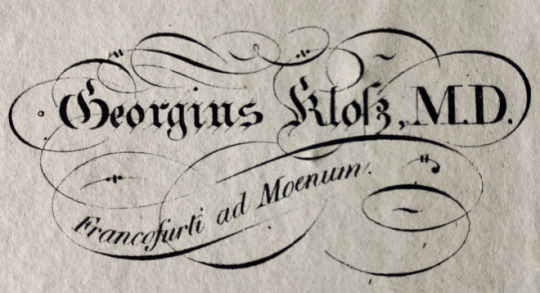
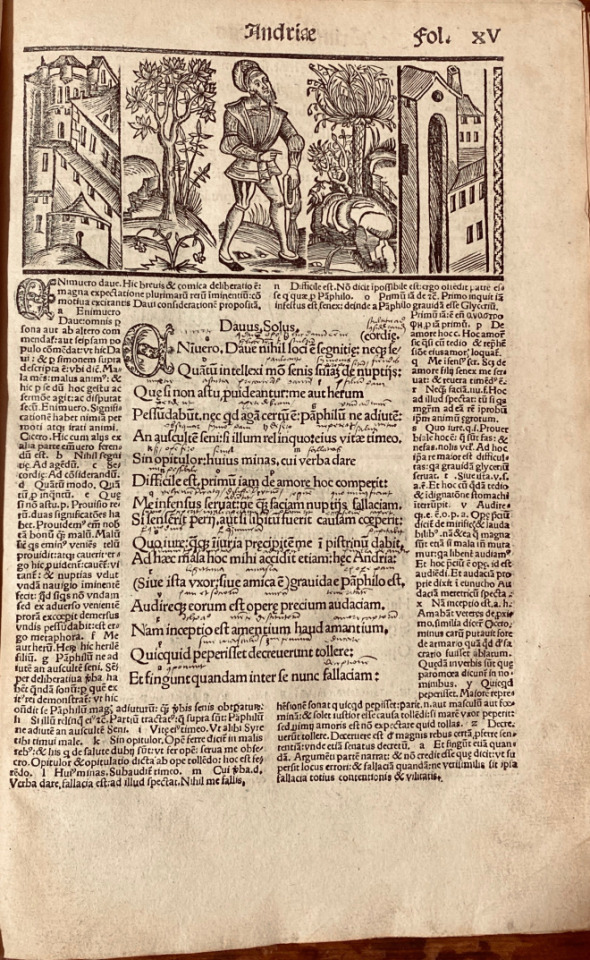

Fascicule XXI. Media Plaga 3-4/2020 Only a day or two ago I was notified that I was in contact with some people tested for and found positive for Covid-19, this came as nothing un expected, I was in contact with hundreds of people many from Europe recently.
#early printed books#fascicule XXI#George Kloss#illustrated incunabulum#Incunabula#Irish authors#irish/gaelic printing#Kircher#Not in Goff#rare book catalogue
9 notes
·
View notes